Introducing the ‘Guilvinec Gull’: a commented gallery of presumed hybrids Herring x Lesser Black-backed Gulls from Brittany, France
Since I moved to Western Brittany a few years ago, I have spent quite some time gull-watching along the many harbours and beaches of the region, especially around the Quimper area. Here, Herring and Lesser Black-backed Gulls are regular breeders, but Yellow-legged Gull is a scarce visitor and thus always a very welcome species for local birders. Based on our local wildlife database, Yellow-legged Gull should be a regular bird in winter, as there were numerous records reported, involving almost exclusively adult and subadult birds. Frustratingly, during my first years here I was unable to connect with the species as frequently as I had expected, except for a few known, long-staying individuals. Things were a bit different in late summer and early autumn, when I was way more successful in finding many first-cycle Yellow-legged Gulls.
In winter, I did find a number of intriguing yellow-legged Herring Gulls or more confusing birds that exhibited mixed characters of European Herring, Lesser Black-backed, and/or Yellow-legged Gulls - hereinafter referred to as EHG, LBBG, and YLG, respectively. The combination of features displayed by these birds clearly led me to suspect hybridisation between local EHG (argenteus subspecies) and LBBG (graellsii subspecies). Further reading of literature, discussions with keen gull watchers, and viewing online photos of hybrids and parent species confirmed that I was on the right track.
Interestingly, although these presumed hybrids could be found in various locations, I encountered them more frequently in the port of Guilvinec, which earned them the name ‘Guilvinec Gulls’. After several visits, I estimated that there were at least 5-6 different individuals. During the breeding season, I had the opportunity to observe some of them, although I remained unaware of their exact nesting site. In this harbour, where EHG, LBBG, and GBBG breed, I even witnessed interspecific displays and mating between EHG and LBBG before and during the breeding season. While it is possible that some of the hybrid individuals came from elsewhere, considering that hybridization is known to occur in many European countries, it seems likely that at least some of them had a local origin.
For this post, I have selected gulls from Guilvinec and other locations in South-Western Brittany to create a commented gallery. The accompanying comments hopefully will shed light on the key features to separate these confusing hybrids, although they are not intended to provide a comprehensive analysis. In each case, the illustrated birds are compared to closely related taxa, such as EHG, LBBG, YLG, and, in some instances, Heuglin's gull. Although the context of Guilvinec strongly suggests that these are indeed hybrids, all individuals are regarded as presumed hybrids due to the absence of rings. The lack of rings also means that identifying these birds individually from year to year can be challenging. Therefore, it's possible that bird 03 or 04 is the same as bird 01, and bird 08 may match a previously observed individual. Nonetheless, even if they are the same birds, presenting them here remains valuable, considering that their plumage and bare parts may have undergone changes for various reasons, including changes in age-class, moult, wear and the time of year - plumage evolution in gulls is still a poorly understood subject!
Gallery of presumed hybrids Herring x Lesser Black-backed Gulls
Please click on the pictures to enlarge them and study the birds in further detail.
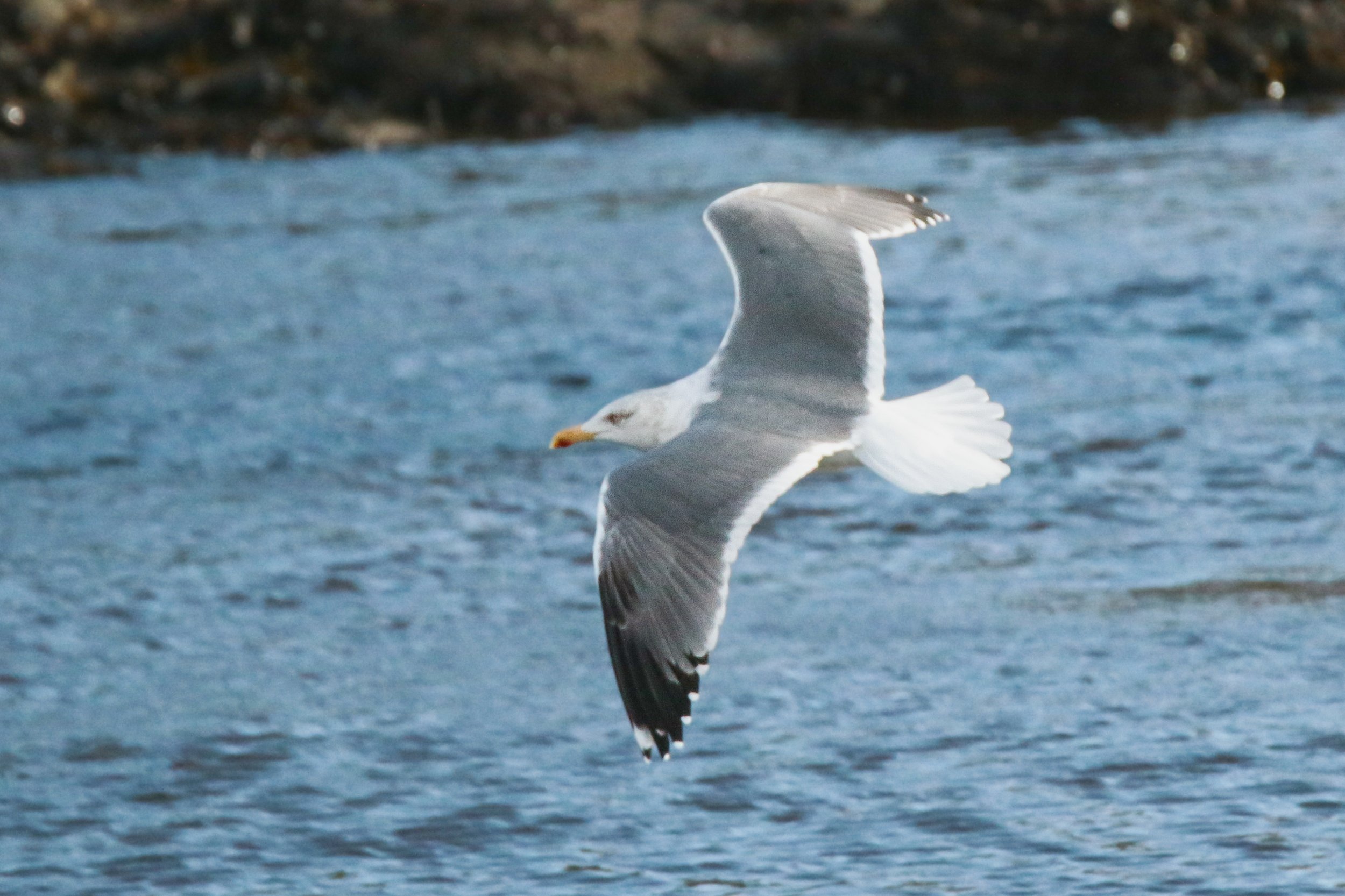
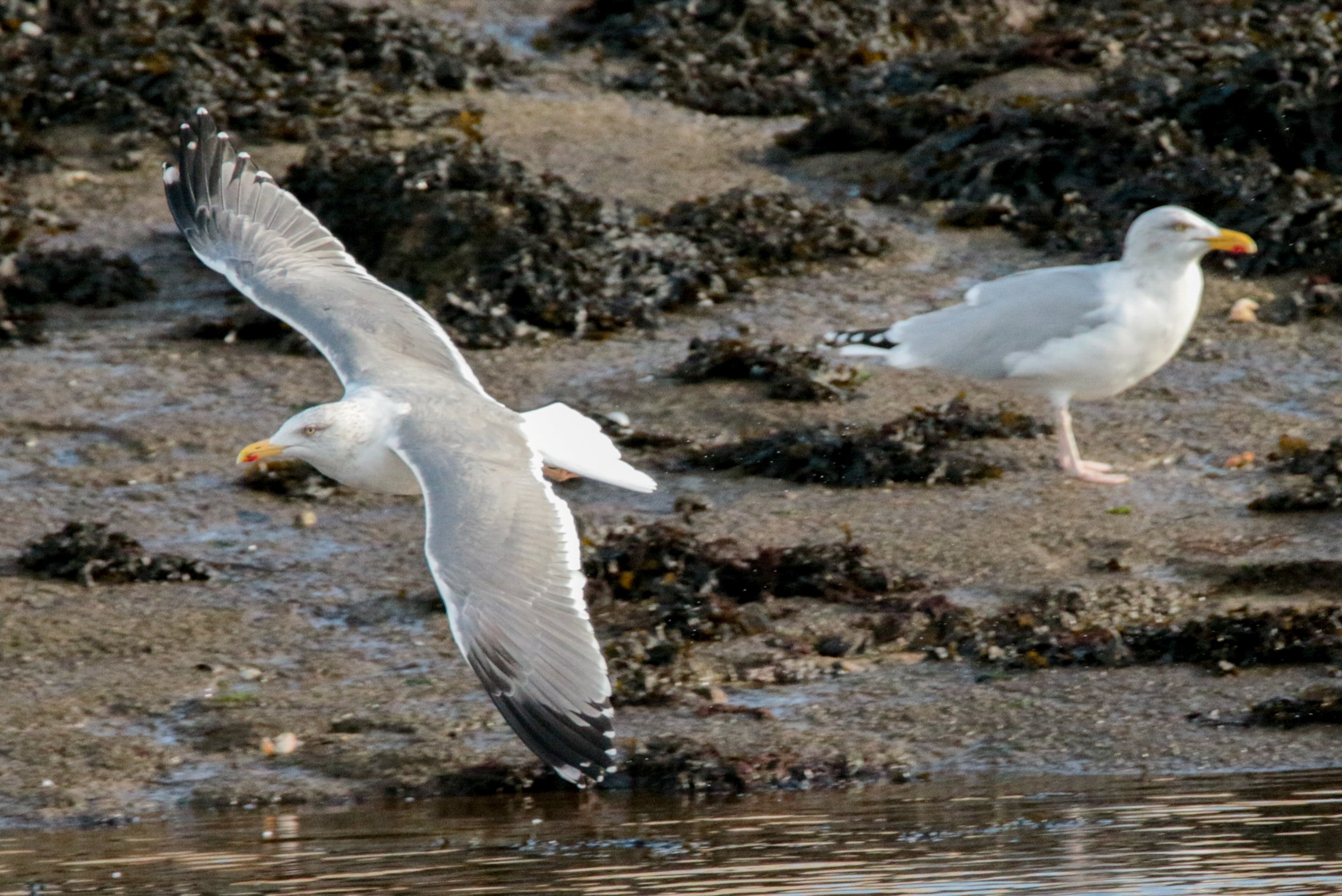
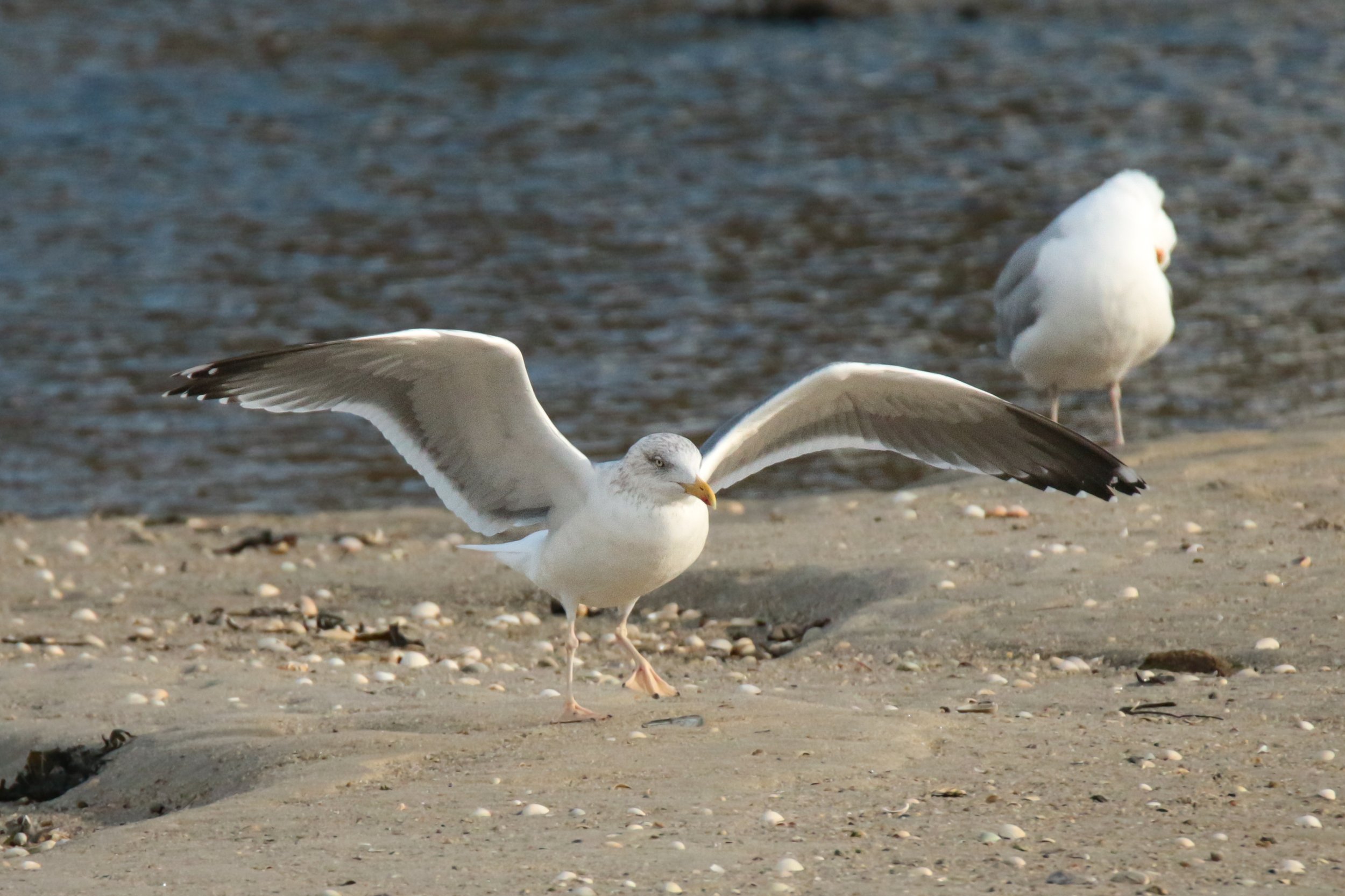
Bird 01. Presumed hybrid European Herring x Lesser Black-backed Gulls, 4th cycle/5cy-type, December 2020, Guilvinec, Brittany, France (Sylvain Reyt). A bird with a rather Herring-like structure, but with short legs and a relatively thin bill. The grey tone of the back looked paler than that of graellsii and darker than that of michahellis. The legs present a pale, dull, flesh yellow colour, thus deviating from either of the two suspected parents. The analysis of the underwing reveals dark primaries and secondaries, creating a notable contrast with the coverts, suggesting a Lesser black-backed influence. Even considering that, as a subadult, it might show more black in the primaries than adult birds, the extensive black coverage -featuring a broad band on P5 and only a short tongue under P10- still points to the Lesser Black-backed lineage. It's worth mentioning that this bird exhibits an asymmetrical and delayed primary moult: the left wing's moult is complete, while the right wing's P9-10 are still growing, reminiscent of the late moult observed in eastern taxa (see the next bird for further comments on Heuglin's gull). Additionally, it's interesting to note how lighting conditions can affect the perceived grey tone among different photos.
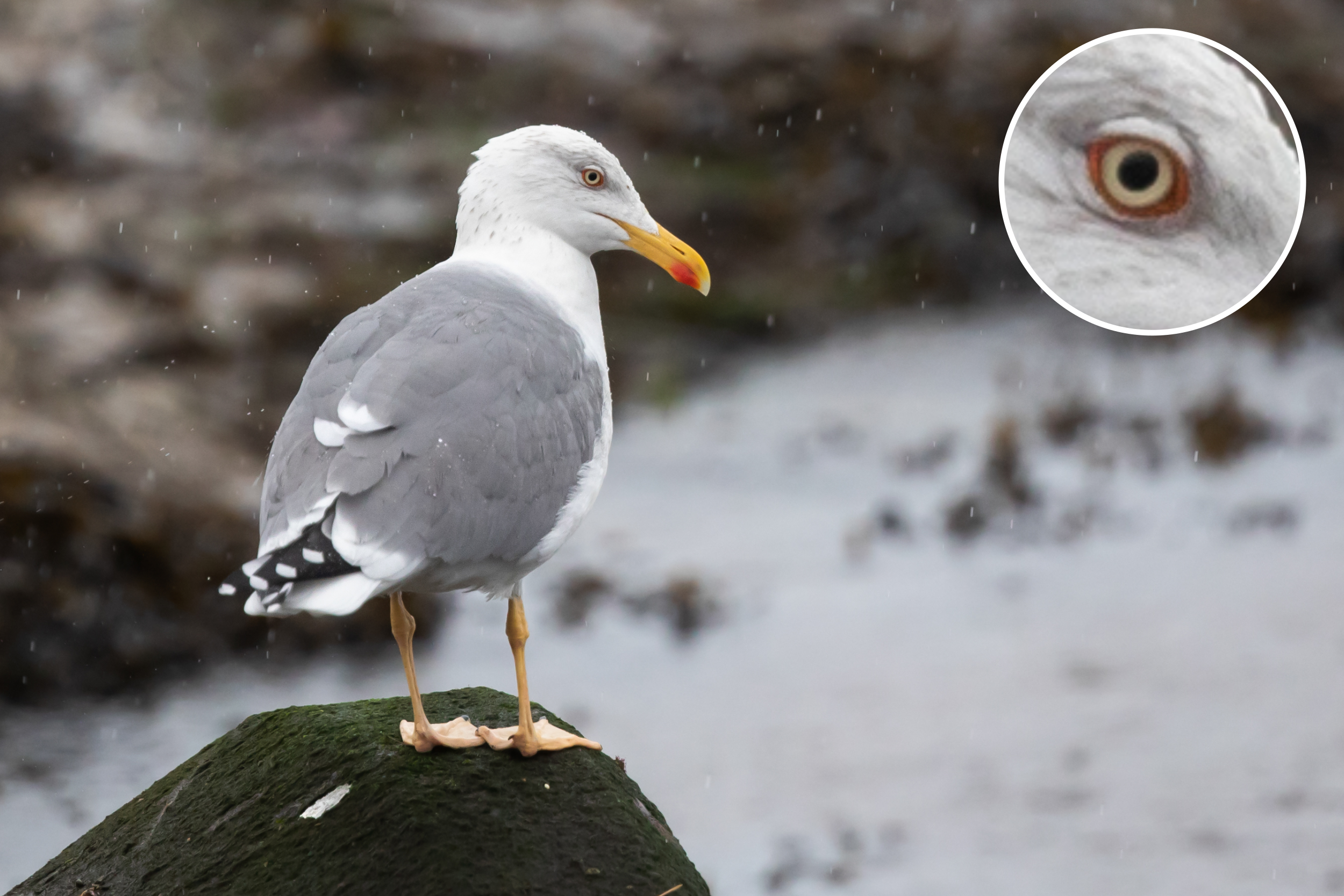
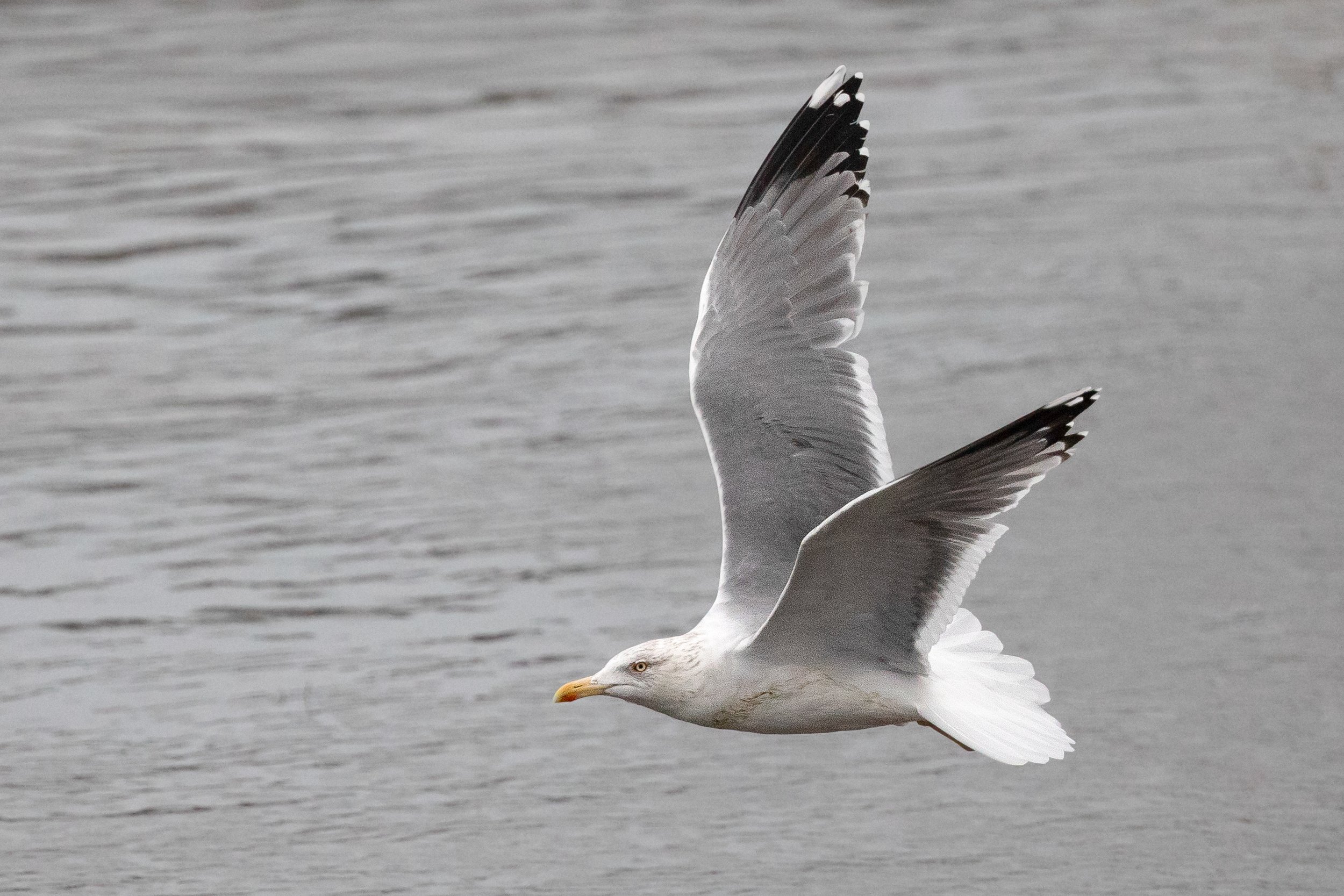
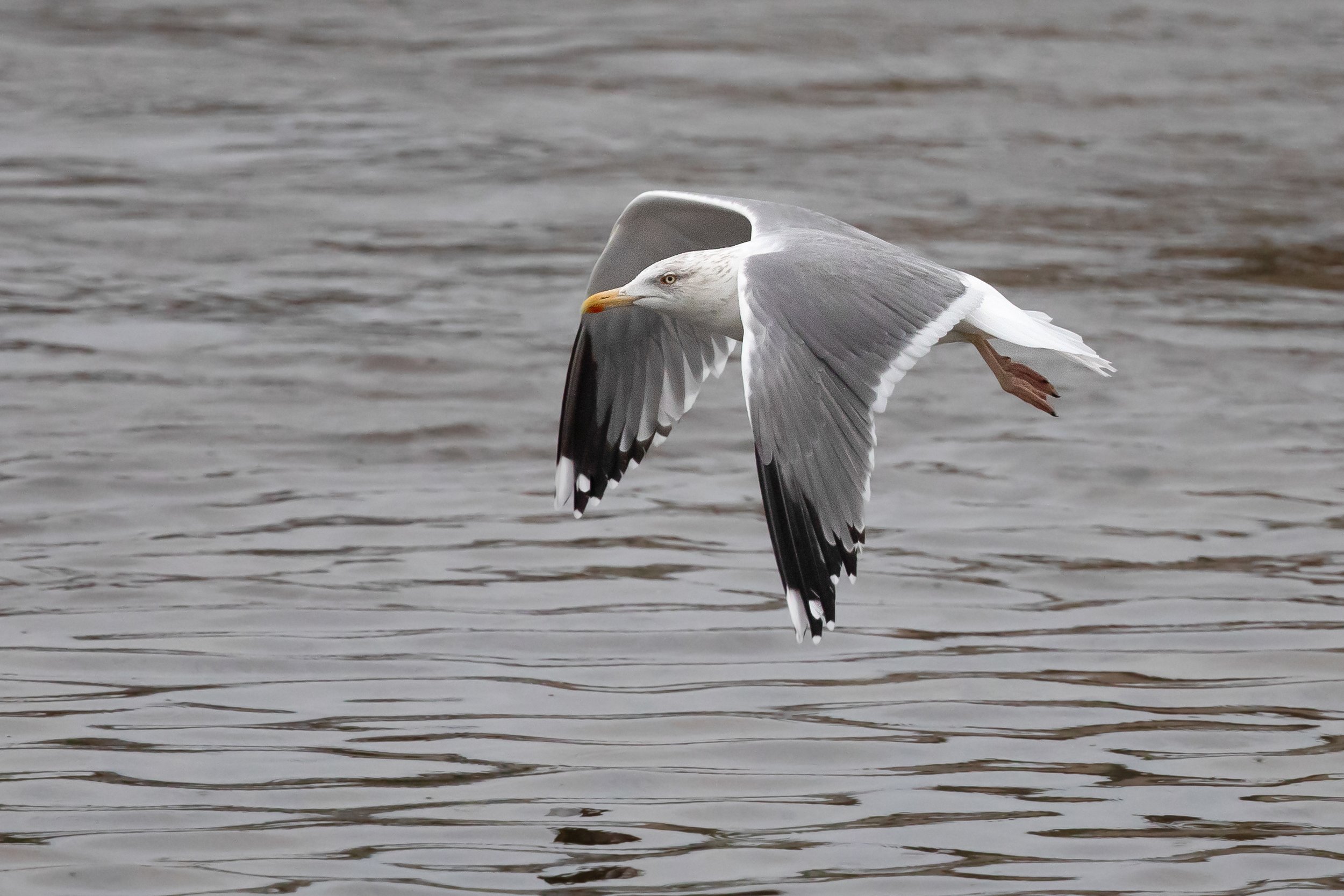
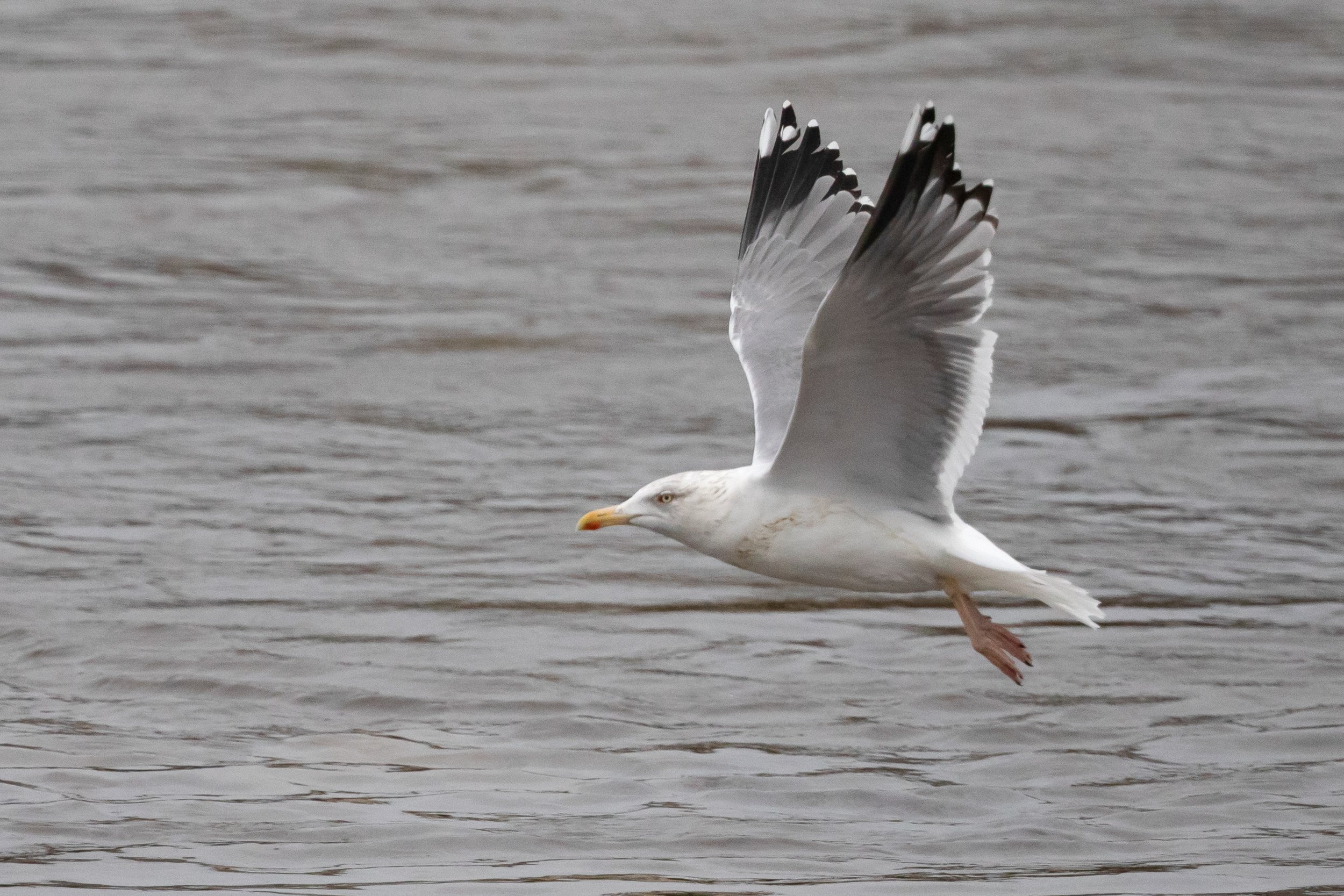
Bird 02. Presumed hybrid European Herring x Lesser black-backed Gulls, adult, December 2020, Guilvinec, Brittany, France (Sylvain Reyt). The bird stands out due to its mantle tone, which falls between the pale grey of European Herring Gull and the darker tone of Lesser Black-backed Gull. On that particular day, while attempting to make a more accurate assessment, I had the impression that it was subtly darker than an average Yellow-legged Gull - unfortunately, lacking a direct comparison, I couldn't confirm this observation. Although the extent of black in the primaries is not particularly extensive, one can observe that the black reaches P4, albeit as a small dot. Notably, this individual displays a late and atypical moult stage, with the left wing's P7 growing and apparent growth of the right wing's P3, prompting discussion about the possibility of Heuglin's gull. This species is known to complete its primary moult later during winter than graellsii and intermedius Lesser black-backed Gulls, sometimes even replacing flight feathers in an irregular order. However, the latter strategy appears to be uncommon in Heuglin's Gull, and several other features do not fit this species. For instance, the head pattern is far from ideal, as Heuglin's Gull should exhibit streaks primarily concentrated on the rear neck. In Heuglin's Gull, the black on the primaries is also more extensive, forming a large black block on the three outer primaries and a complete black band on P4, with reduced white mirrors (often absent on P9). Interestingly, this bird emits long calls that sound very similar to European Herring Gull.
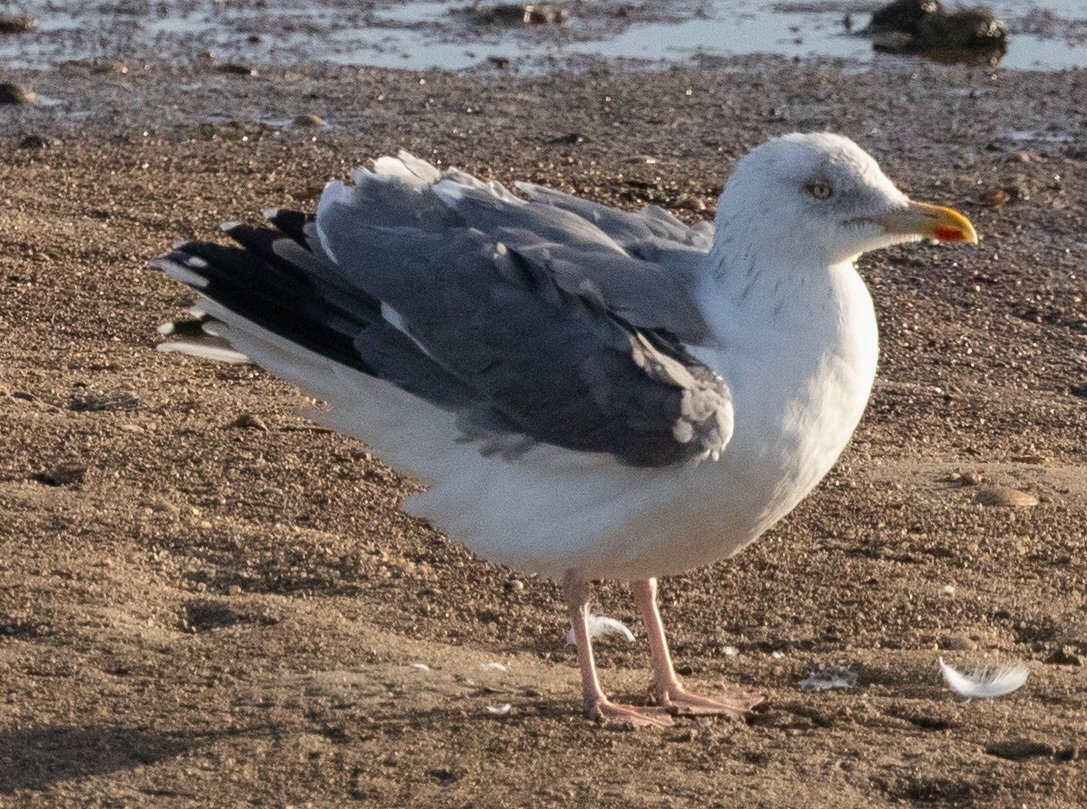
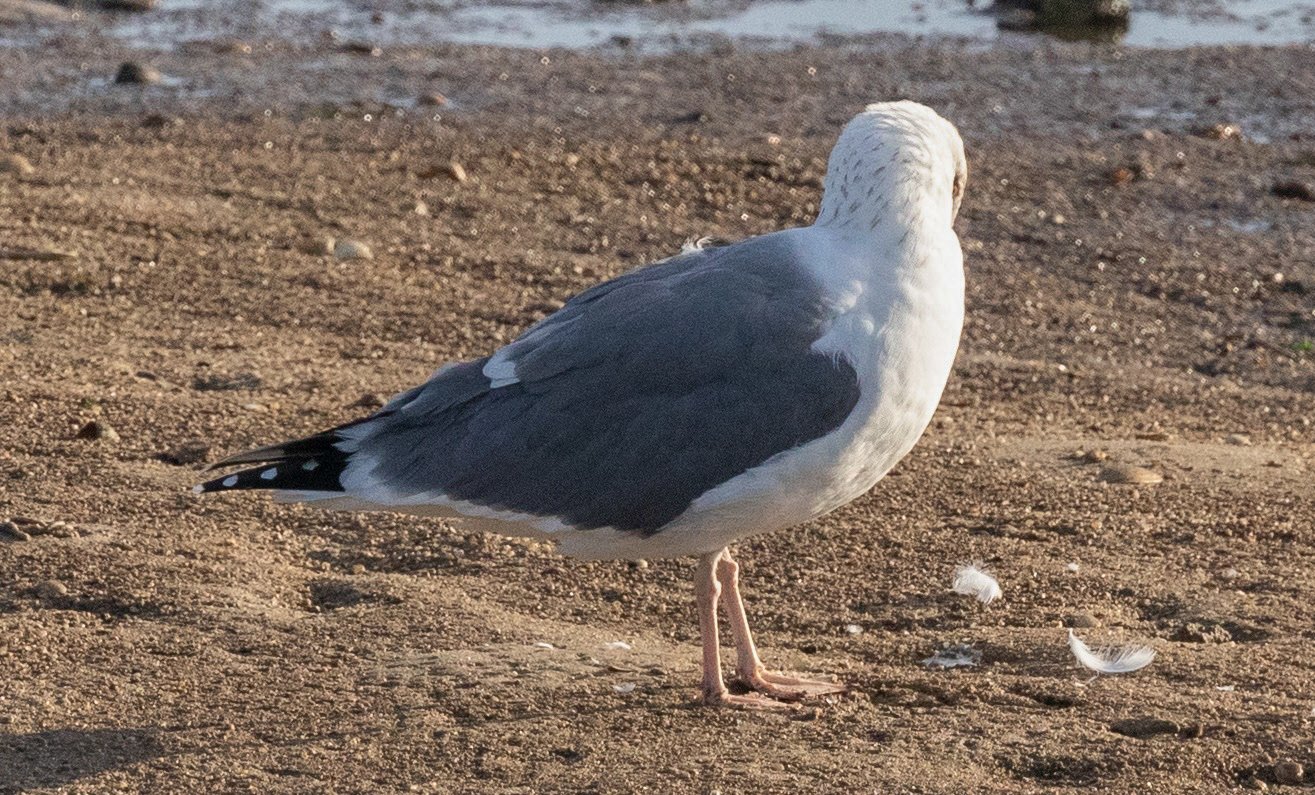
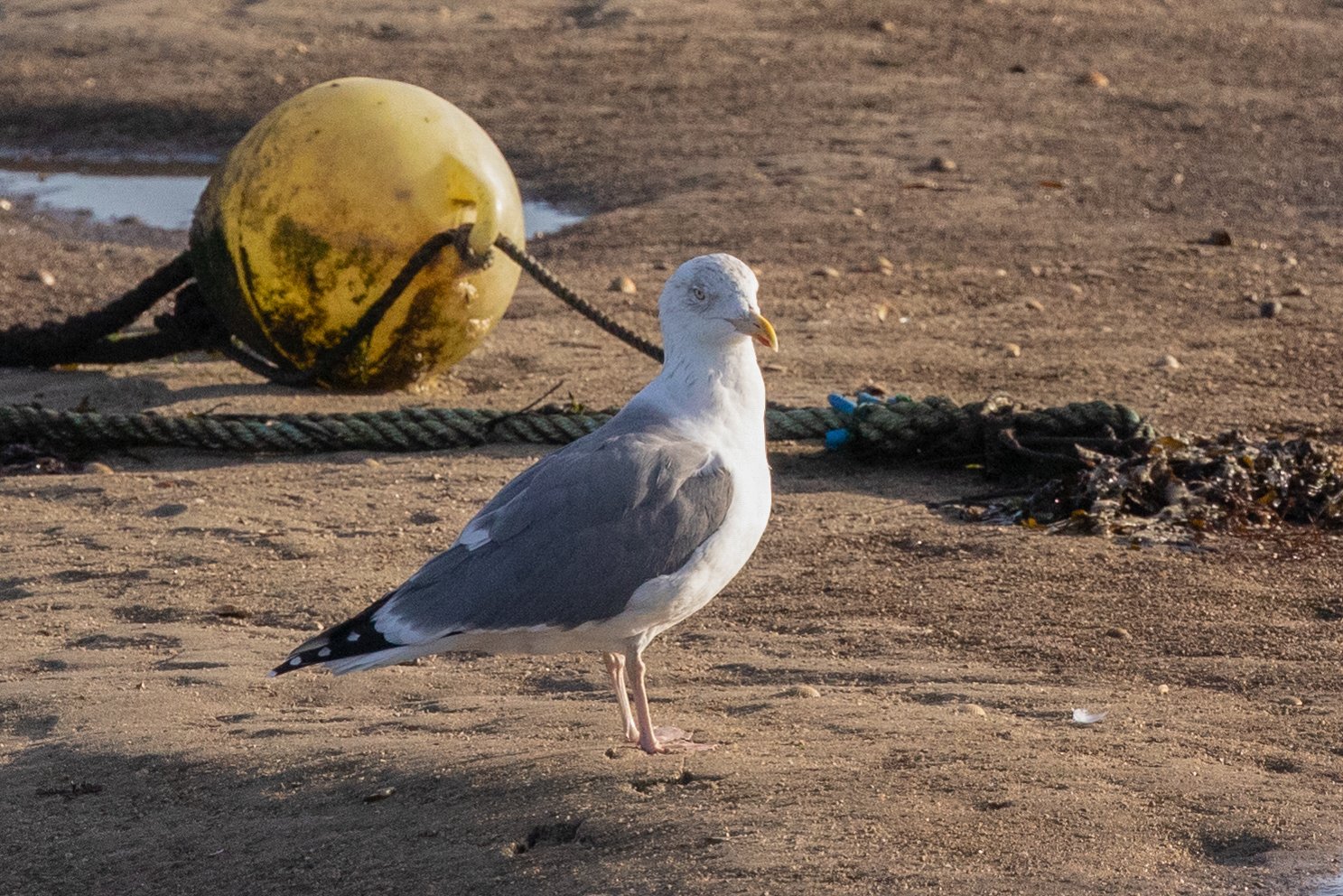
Bird 03. Presumed hybrid European Herring x Lesser Black-backed Gulls, adult, January 2021, Guilvinec, Brittany, France (Sylvain Reyt). The bird's structure appears unusual, featuring relatively short wings reminiscent of European Herring Gull and a robust body along with relatively short legs, resembling Lesser Black-backed Gull. The mantle shade closely resembles graellsii, possibly with a slightly paler hue. Unlike many presumed hybrids, this bird exhibits a well blue-washed grey tone, reminiscent of European Herring gull. The small primary tips, combined with rosy legs, contribute to its distinctive appearance.
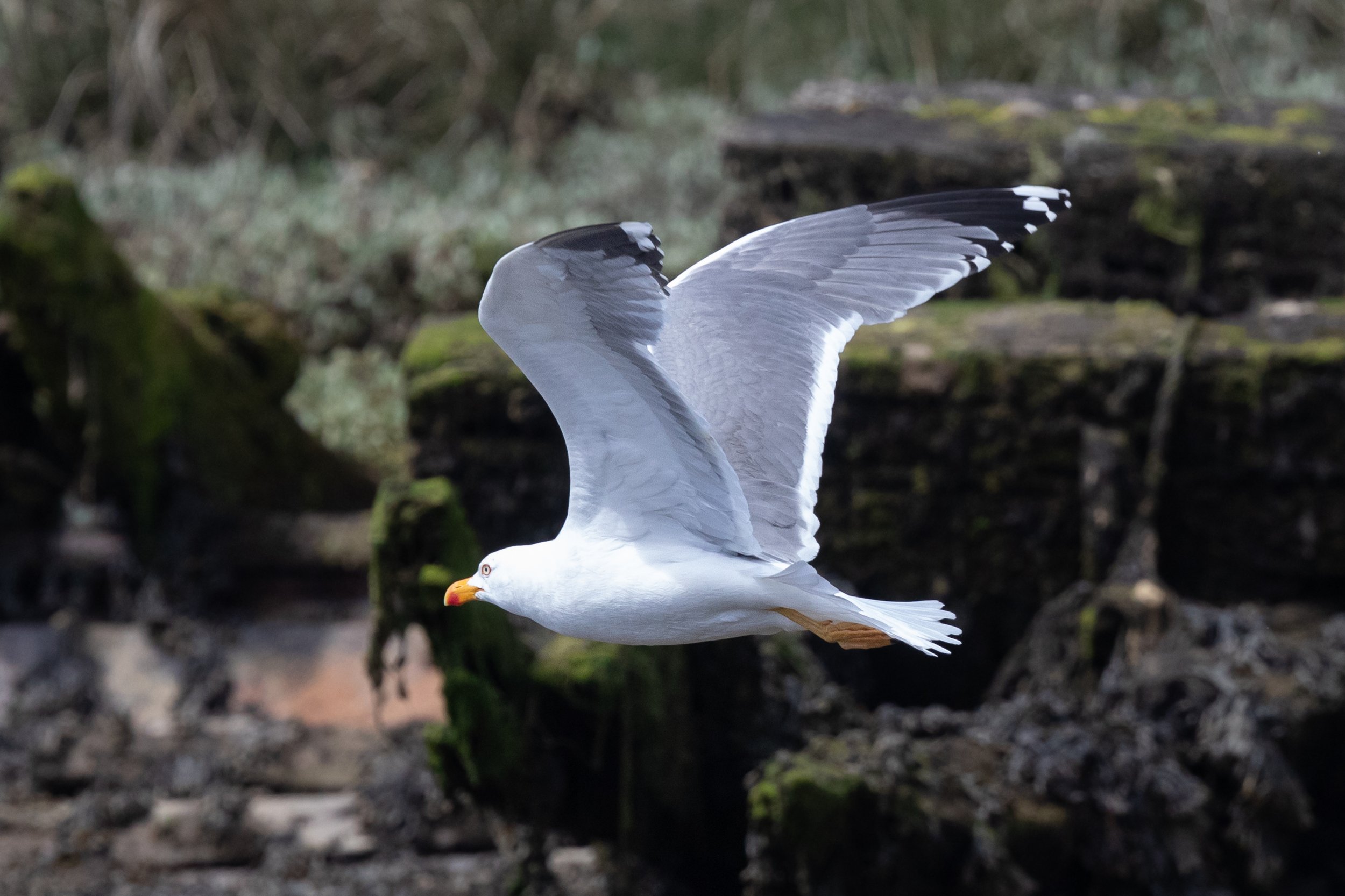
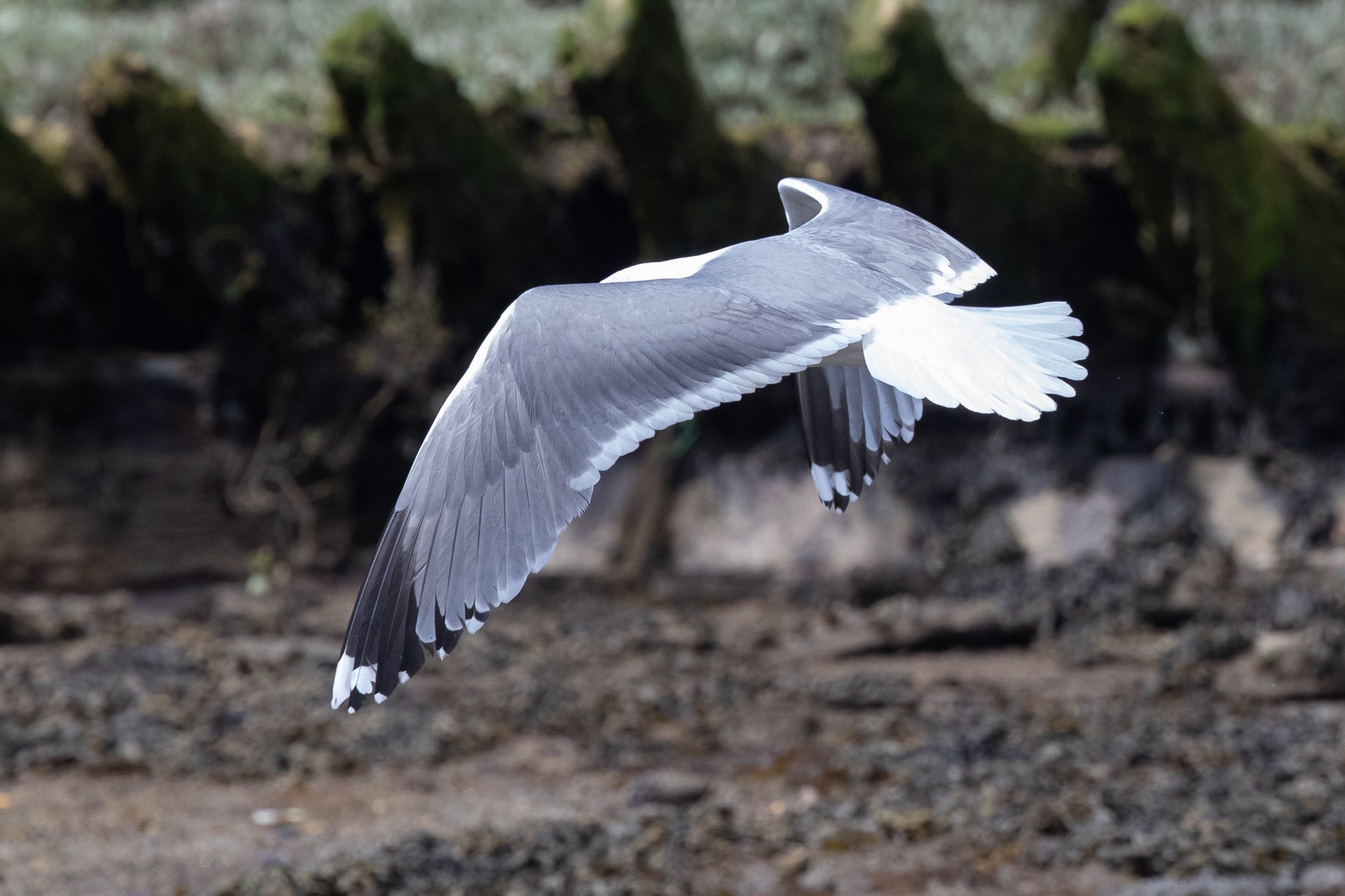
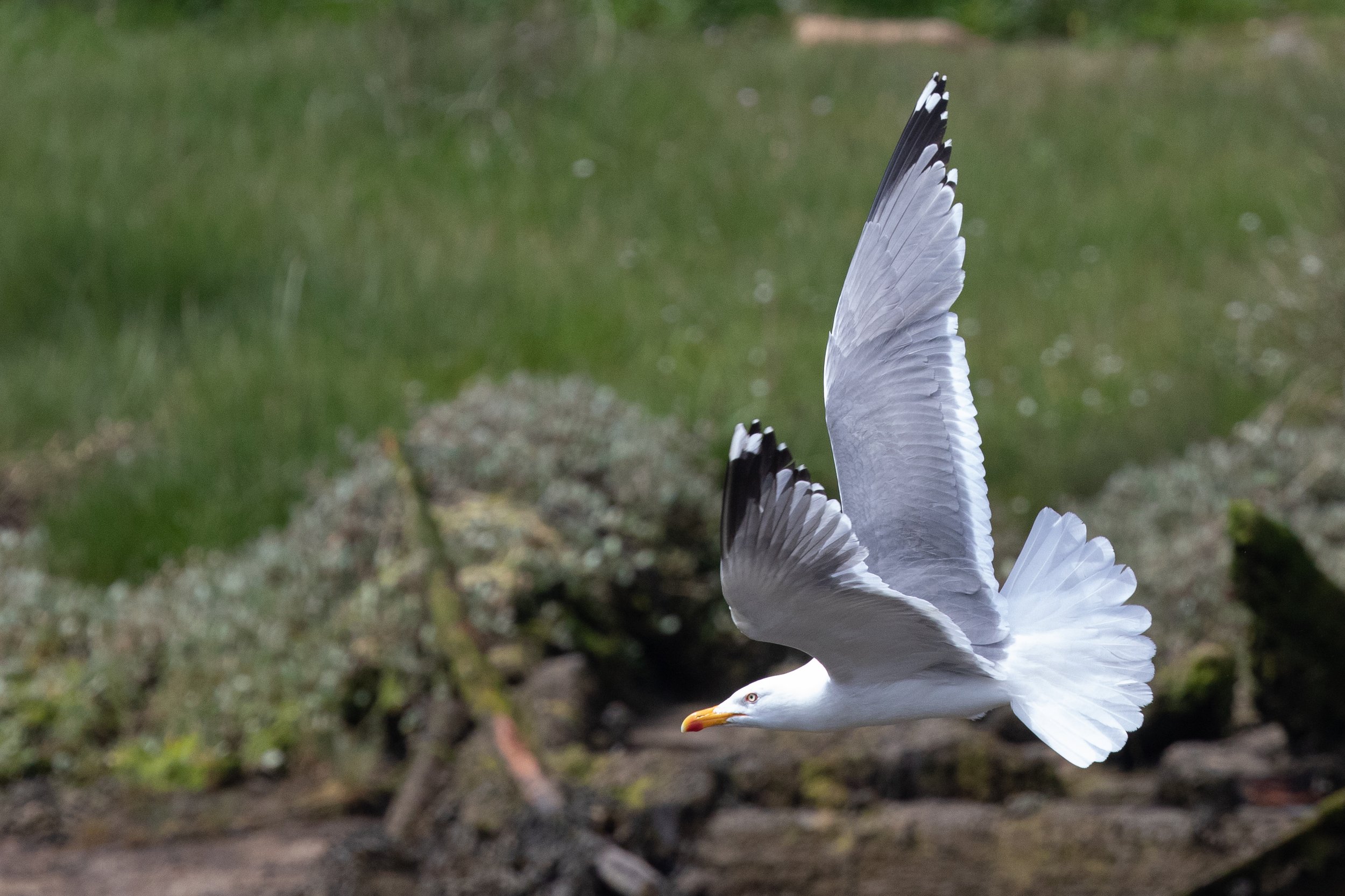
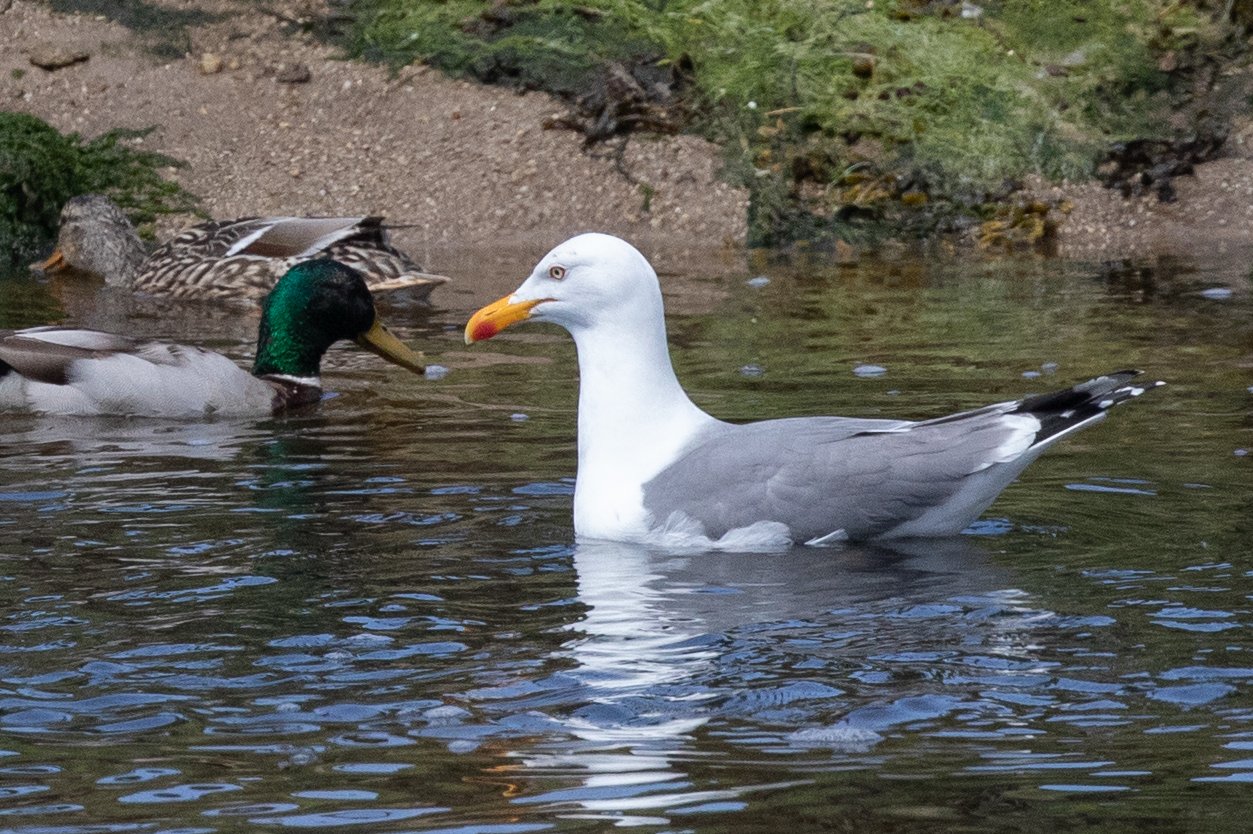
Bird 04. Presumed hybrid European Herring x Lesser Black-backed Gull, adult, May 2021, Guilvinec, Brittany, France (Sylvain Reyt). The bird exhibits several characteristics reminiscent of a Yellow-legged Gull, such as a strong bill, yellow legs, and a red orbital ring. Its elongated structure further adds to the YLG resemblance. The mantle tone appears paler than that of Lesser Black-backed Gull but darker than European Herring Gull. However, it displays an imperfect appearance, likely due to being slightly darker with a slate tinge. Despite its YLG-like features, the bird appeared relatively smallish and short-winged, which could be a bit confusing for a YLG. Unlike most hybrids observed, it only shows a moderate extent of black in the primaries, with two large mirrors on P9-10. The relatively small primary white tips suggest an influence from Lesser black-backed gull, although wear might have contributed to this. Notably, it has a red orbital ring, while most of ‘Guilvinec gulls’ display an orange orbital ring. However, the gape appears yellow instead of the typical red observed in spring YLG.

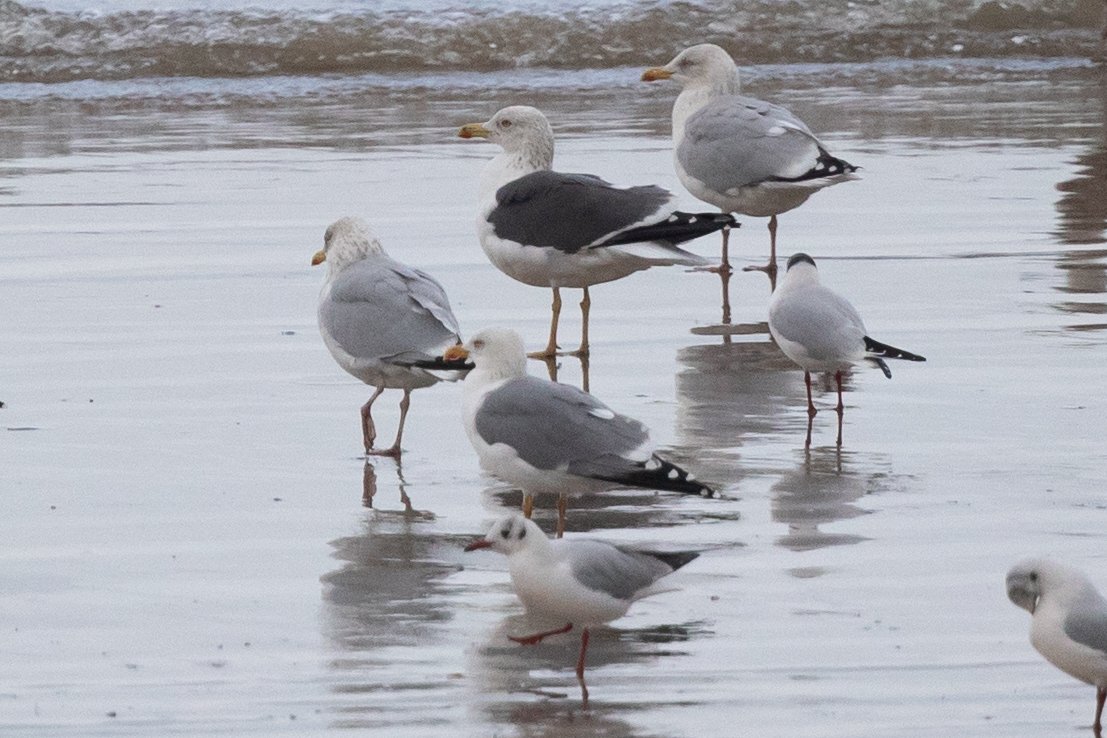
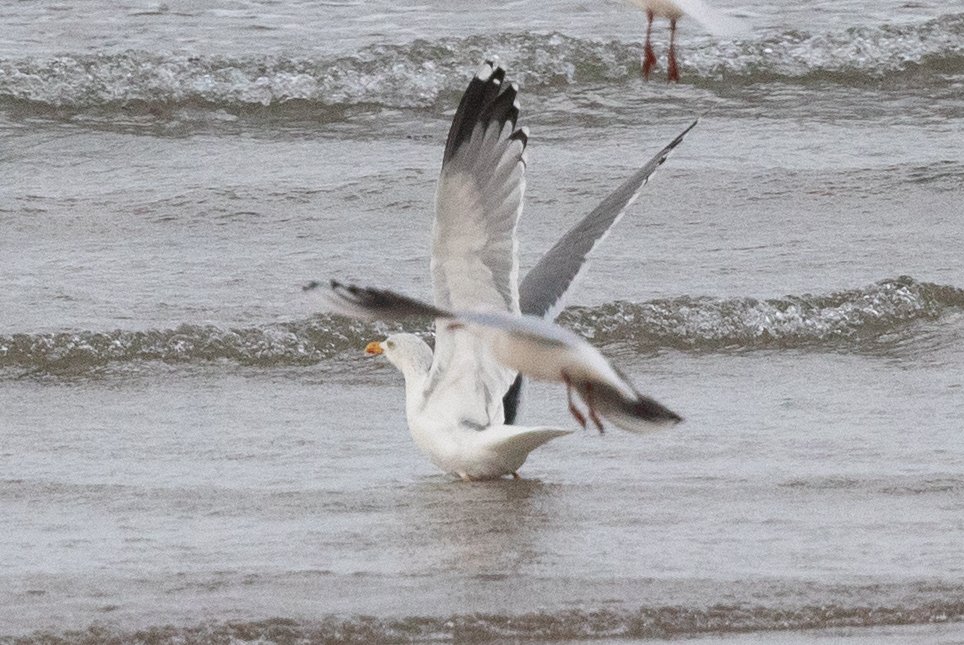
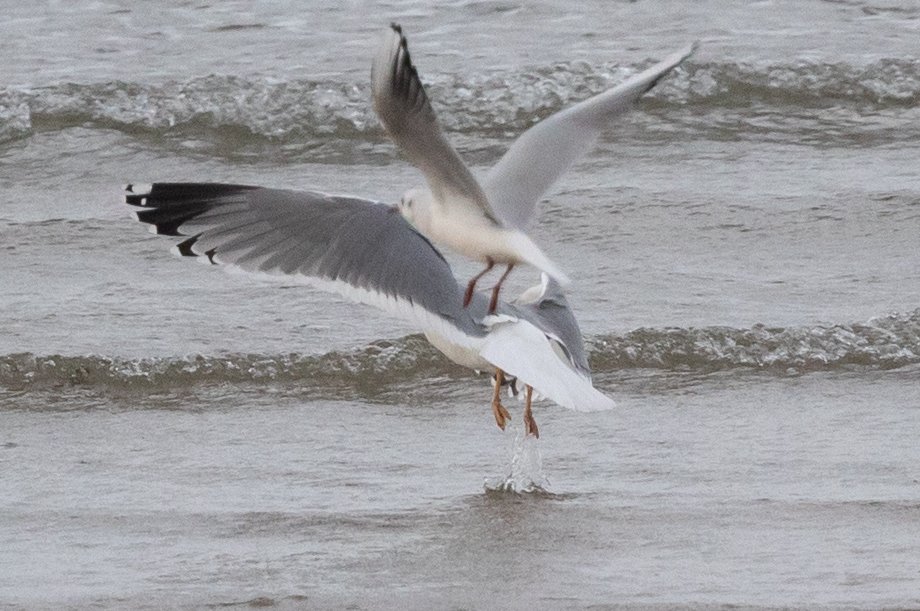
Bird 05. Presumed hybrid European Herring x Lesser Black-backed Gull, adult, November 2021, Douarnenez, Brittany, France (Sylvain Reyt). This bird presents some resemblance to a Yellow-legged gull, especially in terms of mantle tone. However, it features a relatively thin black band on P5 (falling within the YLG variation), and the ventral face of the secondaries appears subtly darker than in a YLG. More importantly, the bird shares the size and structure of a European Herring gull, although the wing may appear elongated in the pictures. The bill appears weak, approaching that of a Lesser black-backed gull. The head pattern also deviates from the ideal pattern of a YLG, as the streaks are not confined to the head and are barely visible on the head's sides, but rather visible on the nape and neck sides.

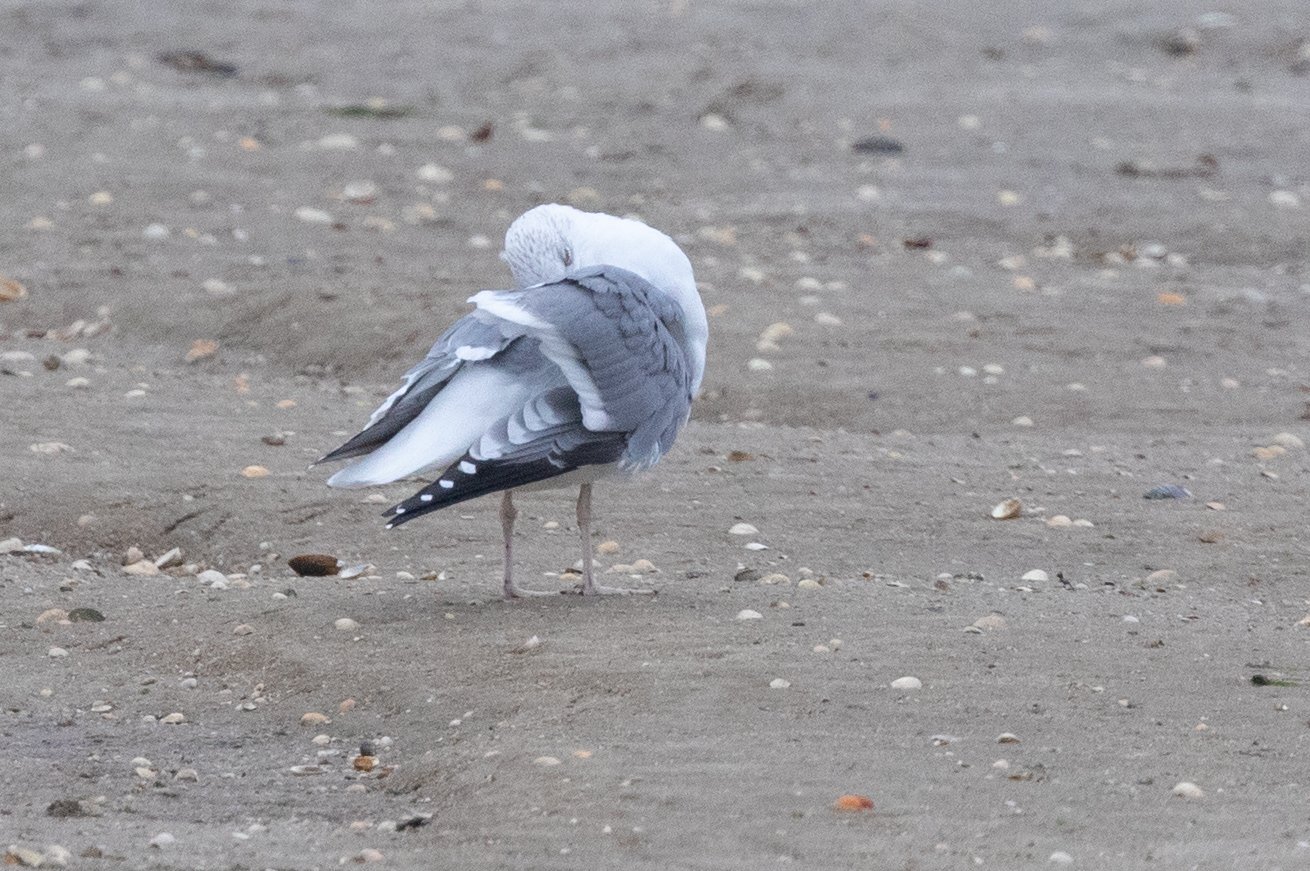
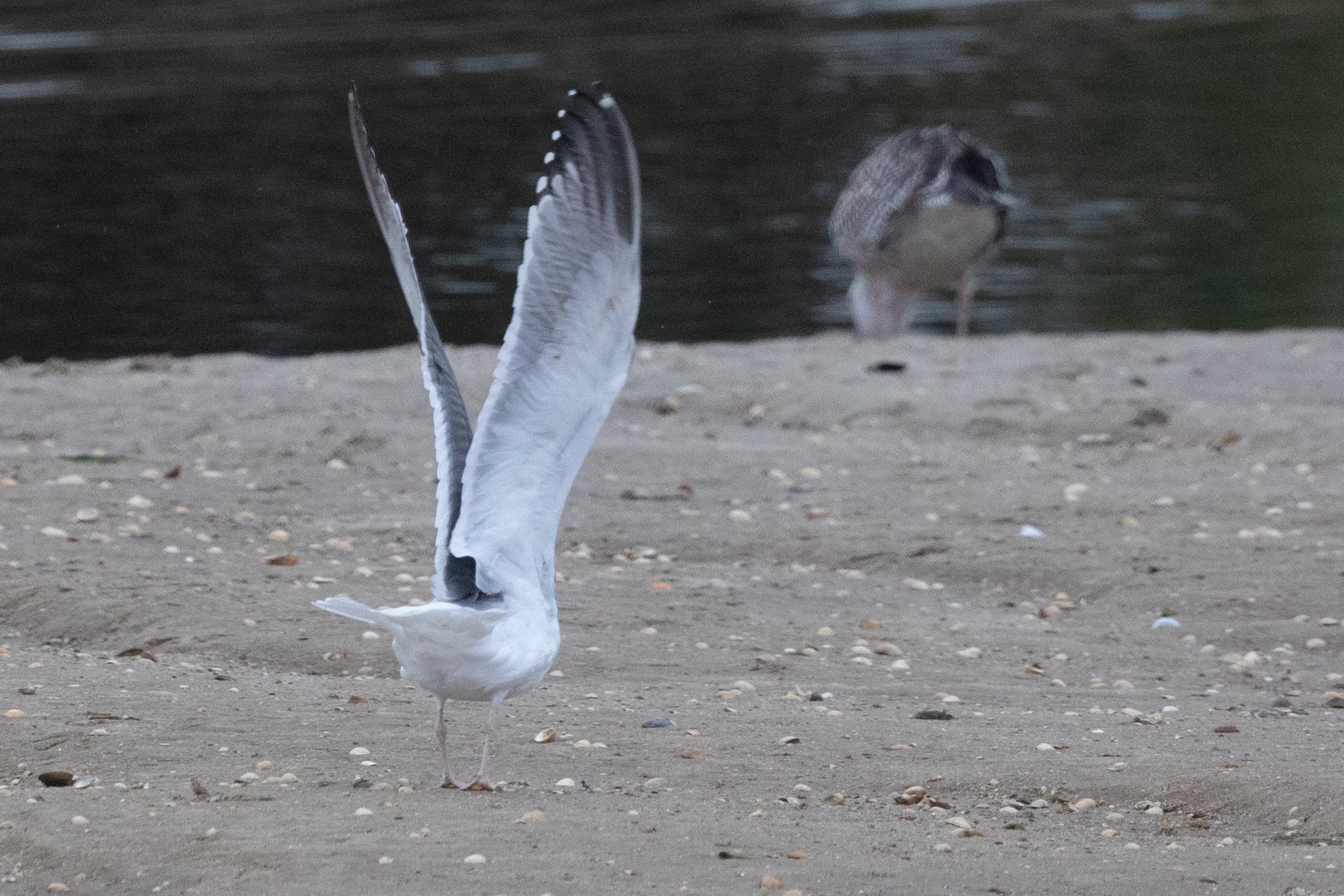

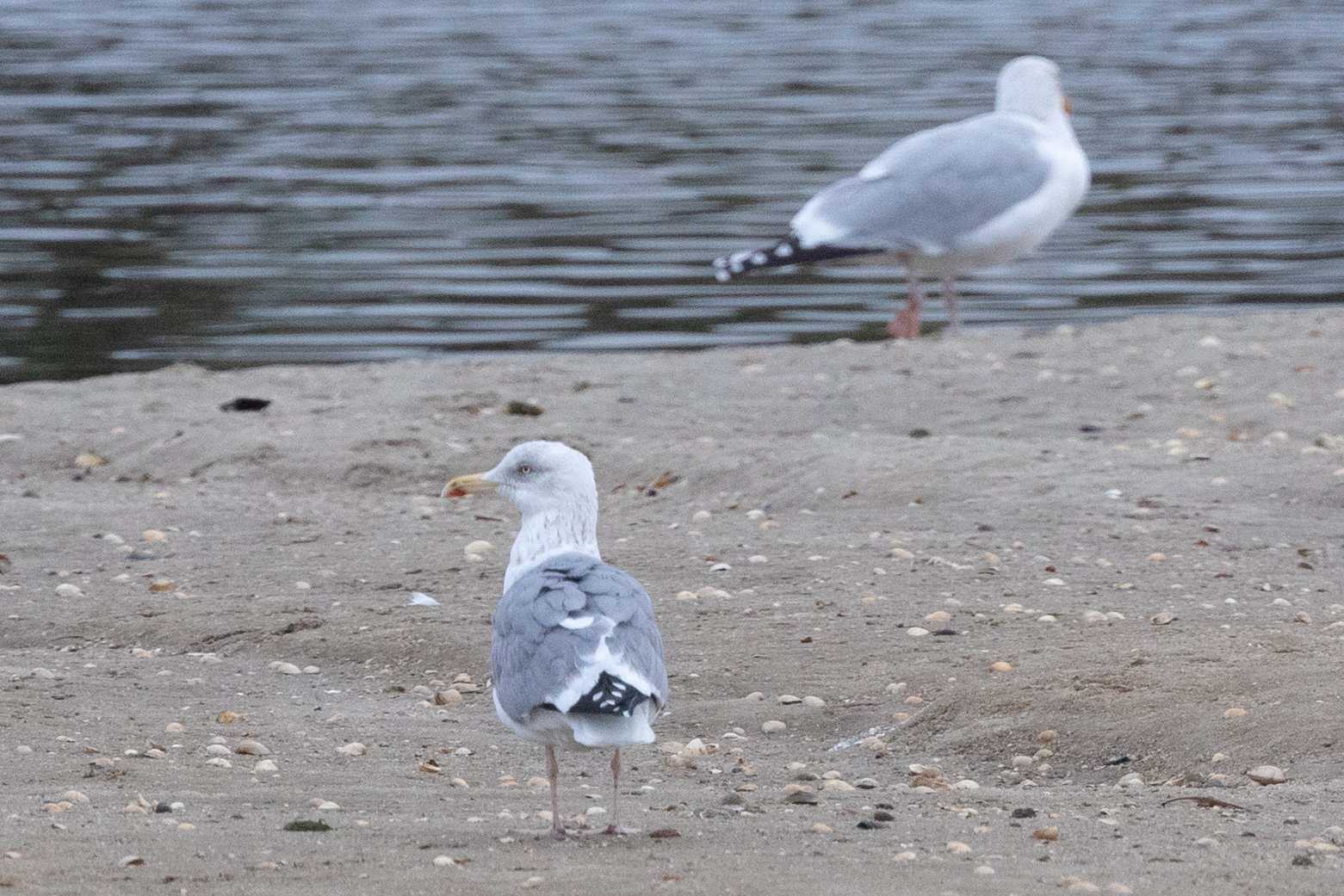
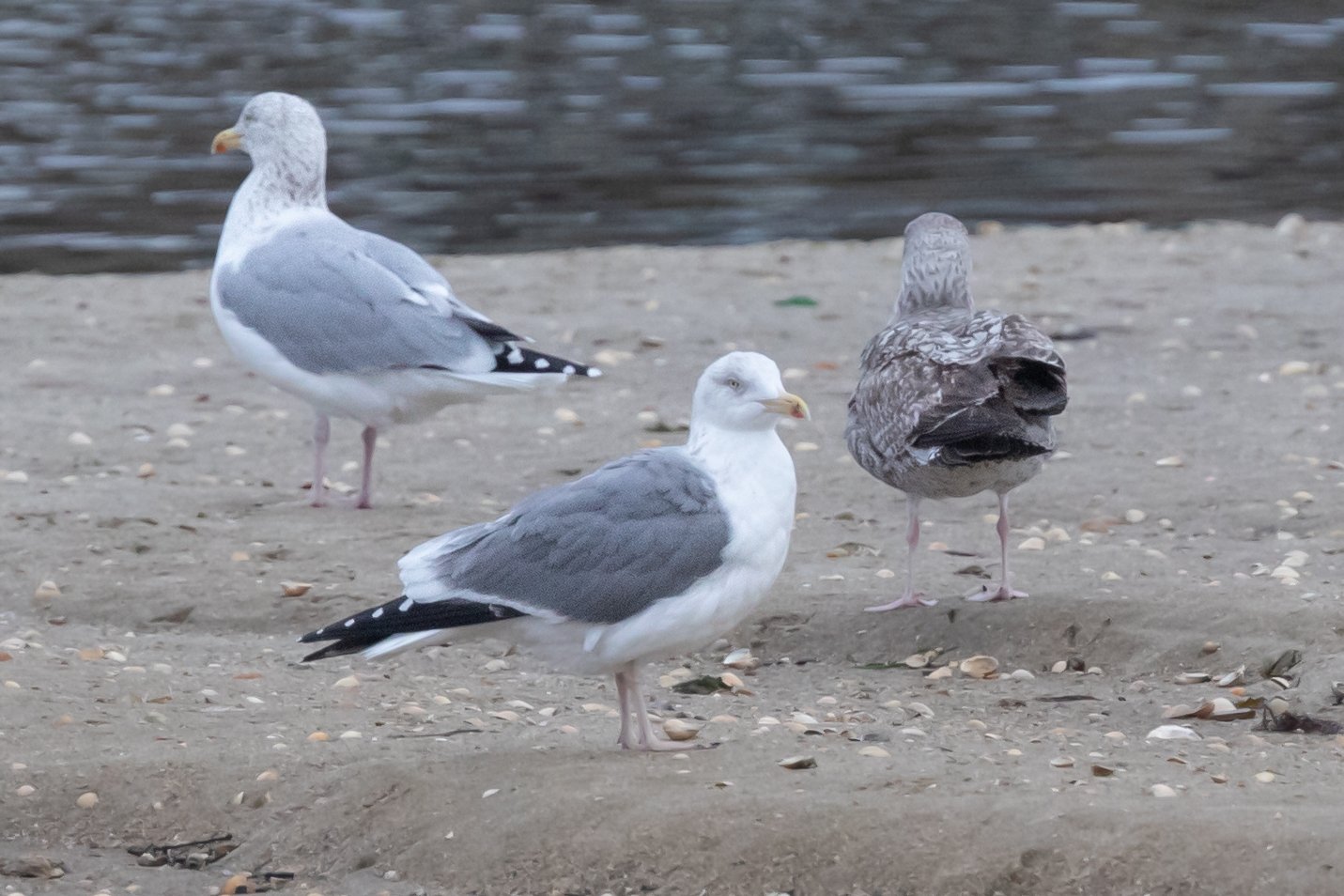
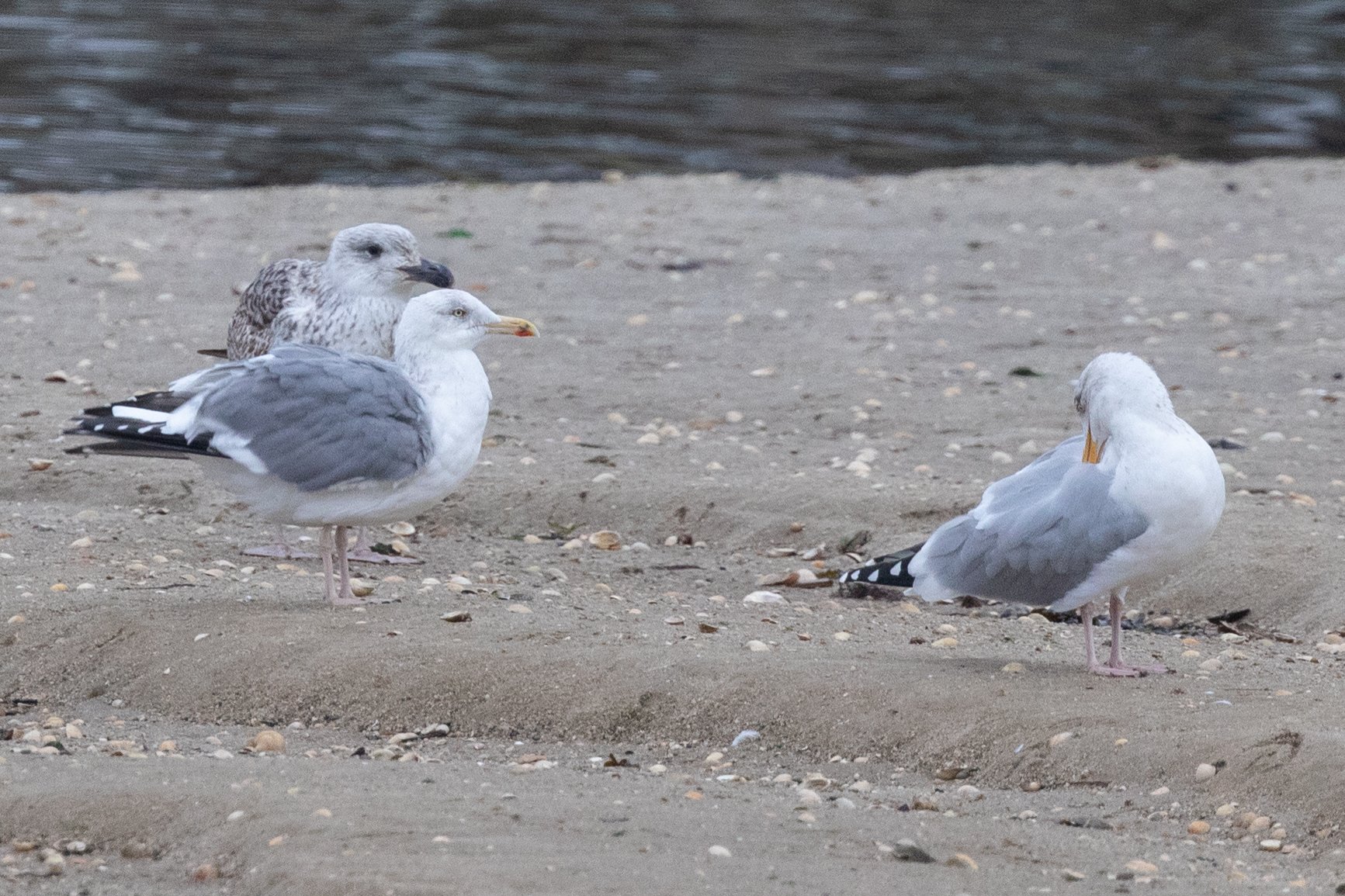
Bird 06. Presumed hybrid European Herring x Lesser Black-backed Gulls, adult, January 2022, Guilvinec, Brittany, France (Sylvain Reyt). At first glance, its dark upperparts, which still retain a bluish hue (unlike many hybrids), and vaguely pinkish legs may lead one to consider the resemblance to argentatus. However, upon closer examination, several points of concern emerge. Firstly, the bird lacks a robust appearance and is approximately the size of the surrounding European Herring gulls. Additionally, it exhibits a significant amount of black, with the four outer primaries being fully black or nearly so, to the extent that even the black portion of P7 reaches the primary coverts. Furthermore, P10 is notably small. While subadult European Herring gulls (mainly 3rd cycle birds) can display considerable black in their primaries, the wing in this case appears less advanced, with flight feathers often showing a brown tinge and numerous dark-marked wing feathers. The head and neck markings are poorly developed, contrasting with the broader and more extensive streaks observed in winter subadult argentatus. Finally, the leg colour approaches that of EHG but appears slightly duller and discoloured.
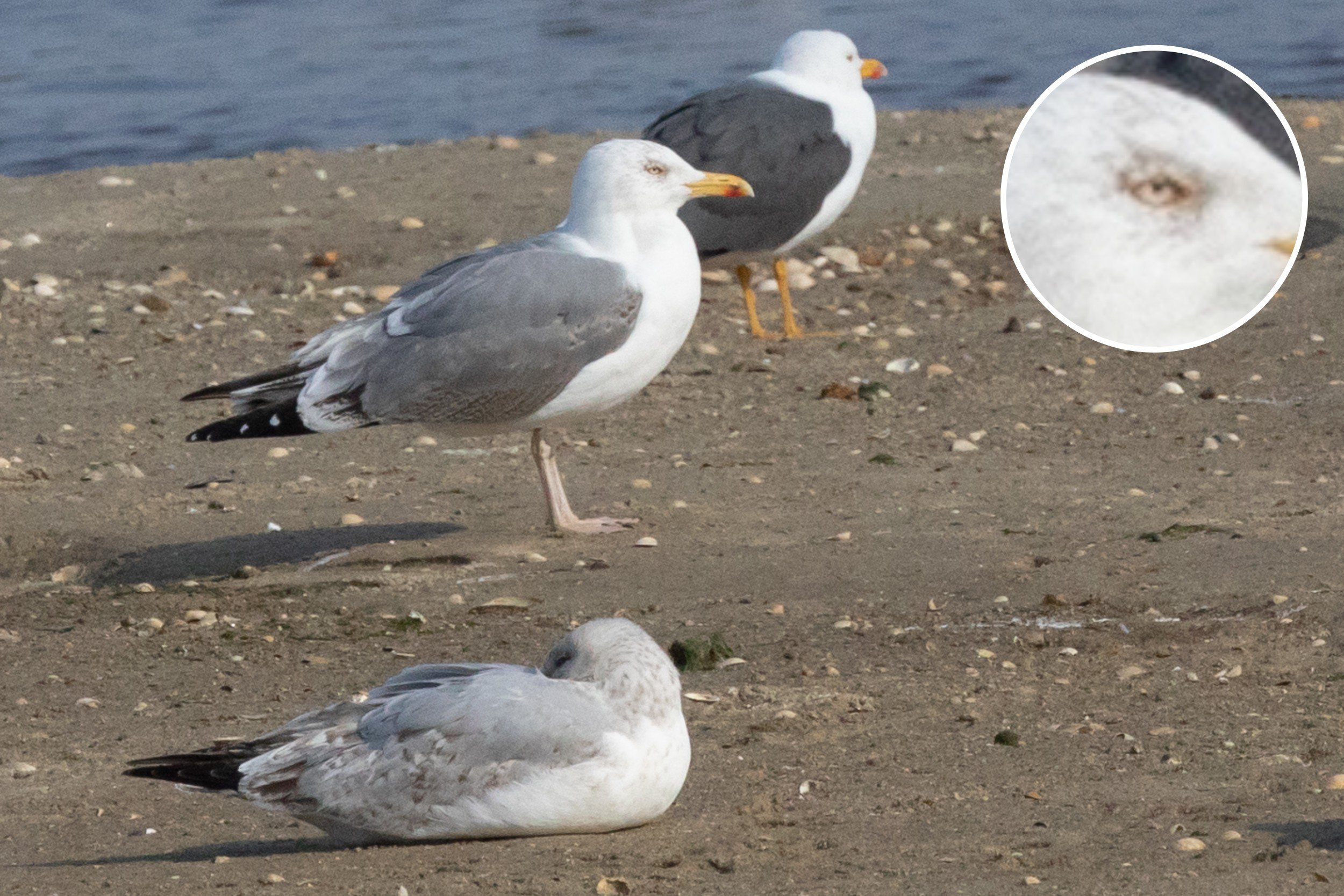
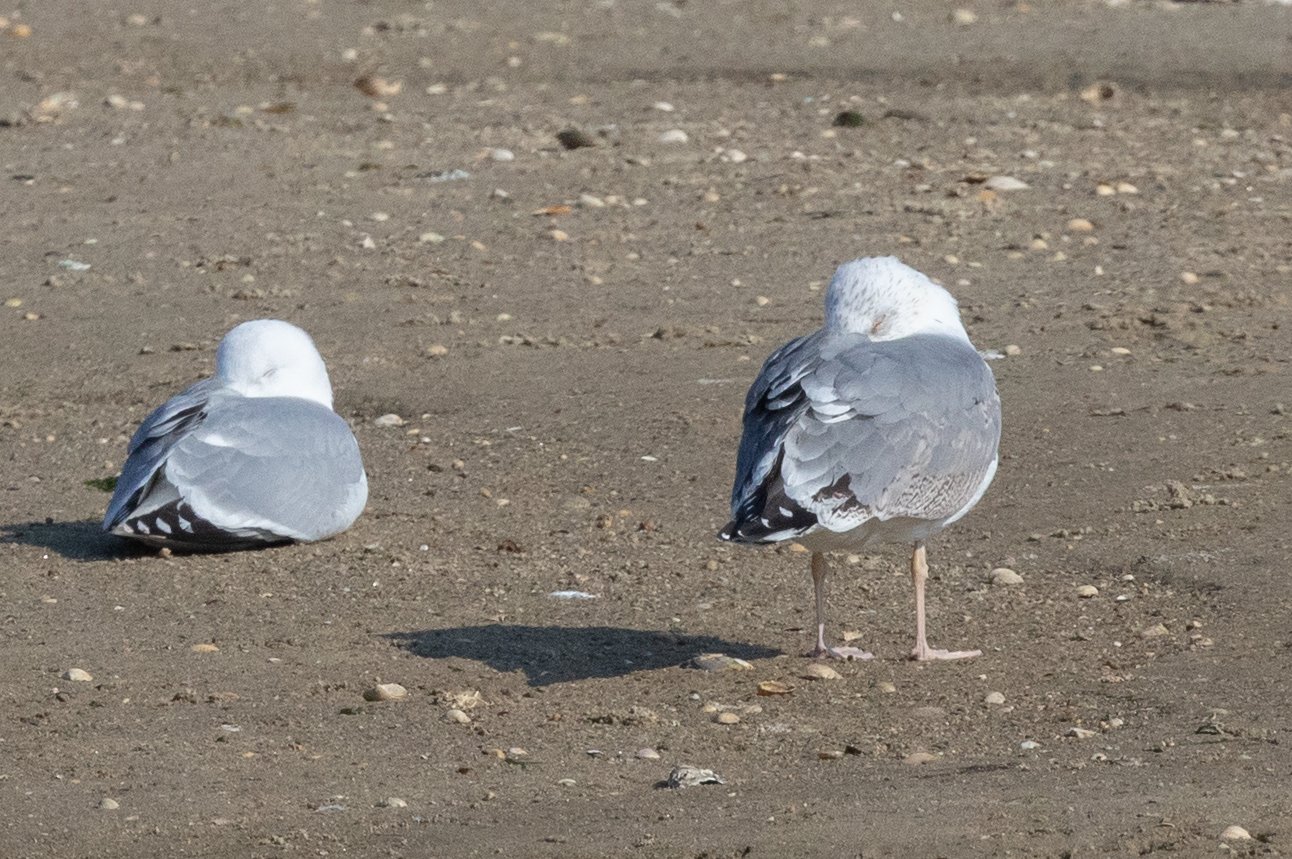
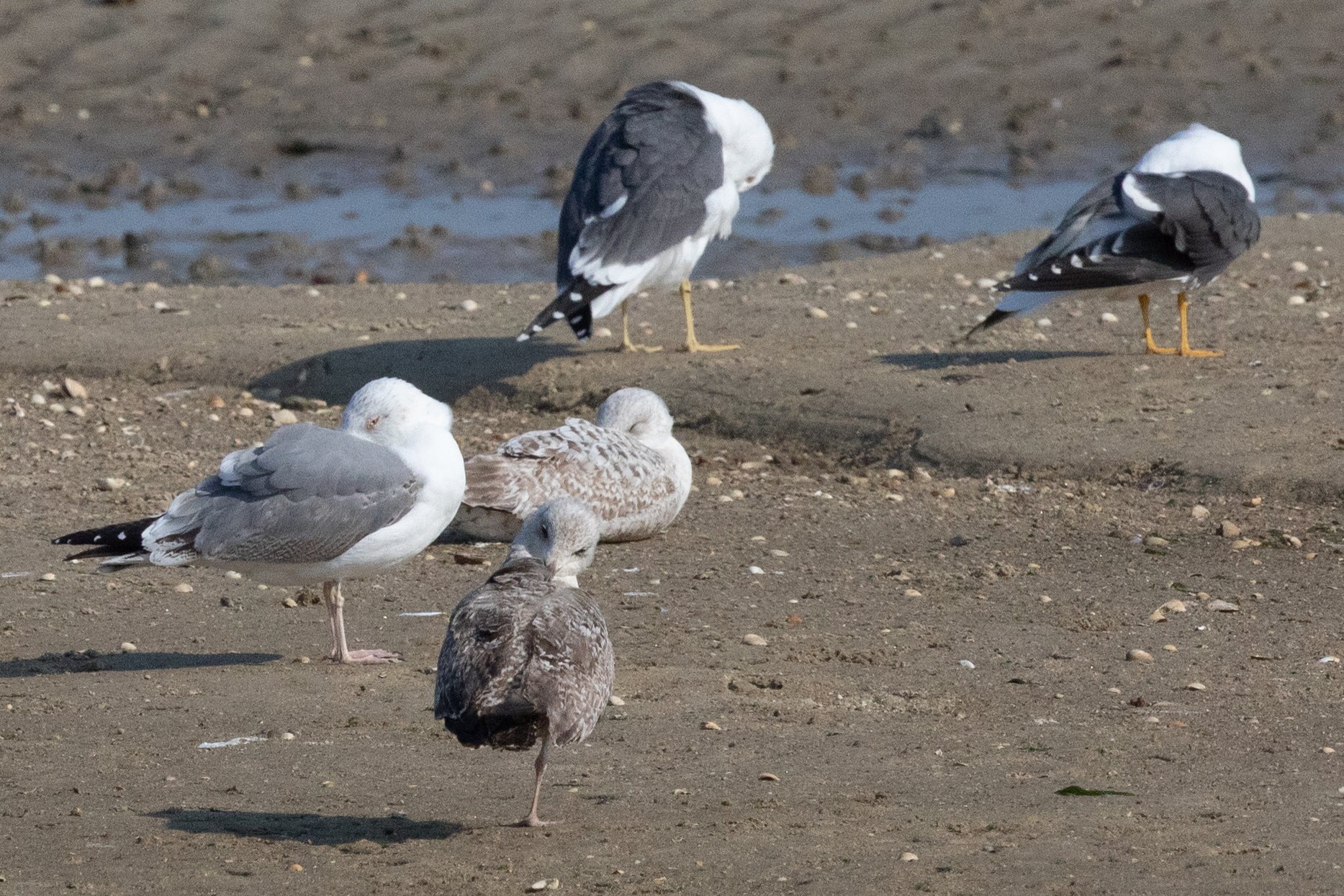

Bird 07. Presumed hybrid European Herring x Lesser Black-backed Gulls, 3rd cycle/4cy, March 2022, Guilvinec, Brittany, France (Sylvain Reyt). It stands out as the only 3rd cycle/4cy bird in this sample. Picture XX perfectly illustrates how the mantle tone does not correspond to either European Herring gull (EHG) or Lesser black-backed gull (LBBG). The bird displays other traits associated with LBBG, such as an orange-red orbital ring, the absence of a mirror on P10, and a well-developed plumage. It also shows characteristics of EHG, including vermiculated greater coverts and a compact structure. The pattern of the tertials could be considered intermediate between both species, with a clearly black base (reminiscent of LBBG) but poorly defined and extensively bordered with small dots.
Bird 08. Presumed hybrid European Herring x Lesser Black-backed Gulls, adult, October 2022, Guilvinec, Brittany, France (Sylvain Reyt). It was closely followed by a 1st cycle EHG-type bird that was begging for food. Unfortunately, there is no way to determine if the 1st cycle bird is its offspring. No open wing shots are available for this adult bird. The bright yellow colouration of its bare parts evokes Yellow-legged gull (YLG). In addition to its structure aligning well with the other ‘Guilvinec gulls’, a detailed examination reveals an orange orbital ring (instead of the red observed in YLG) and an atypical distribution of head and neck streaks for a YLG, as YLGs typically exhibit streaks concentrated on the head, often more densely around the eye.

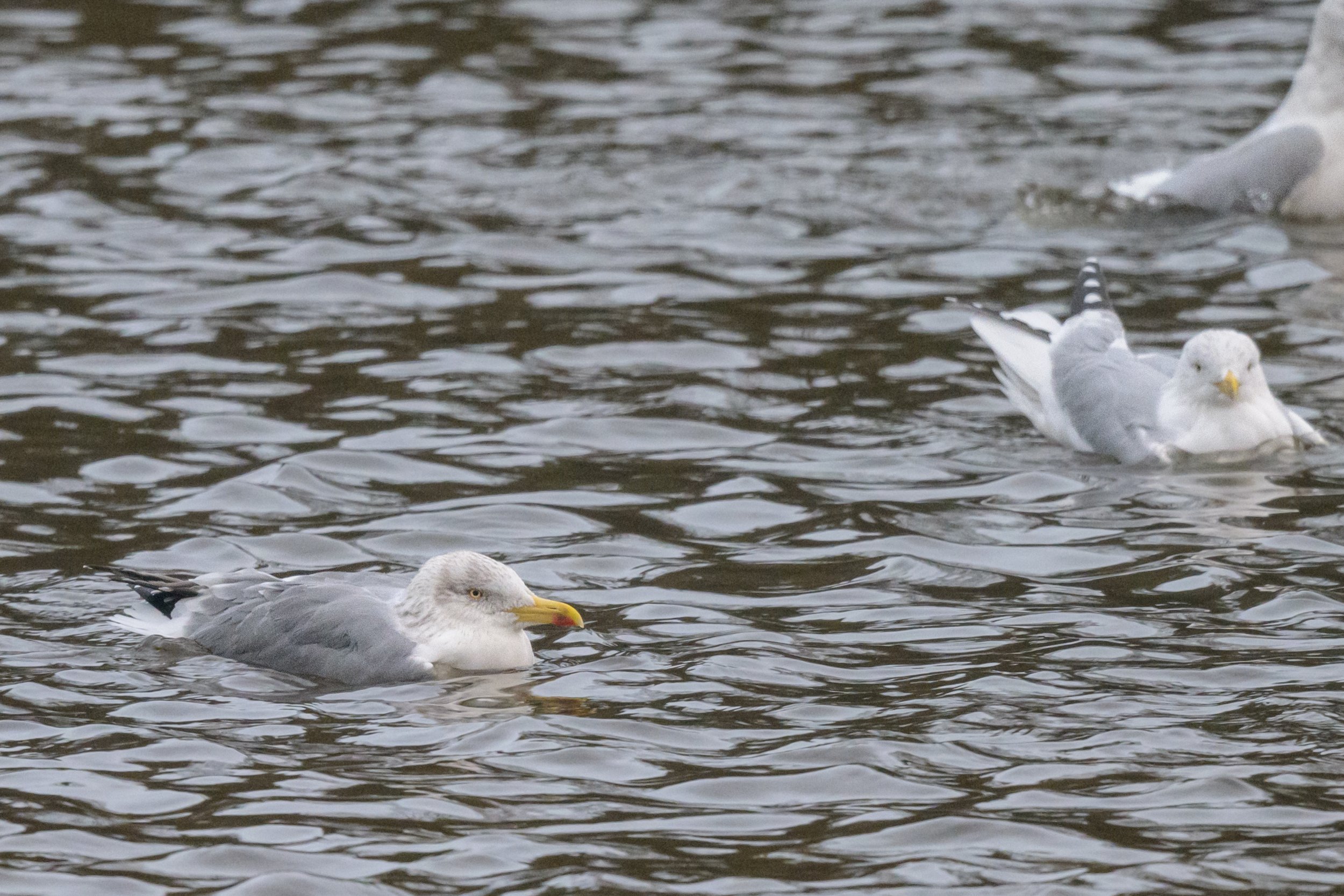
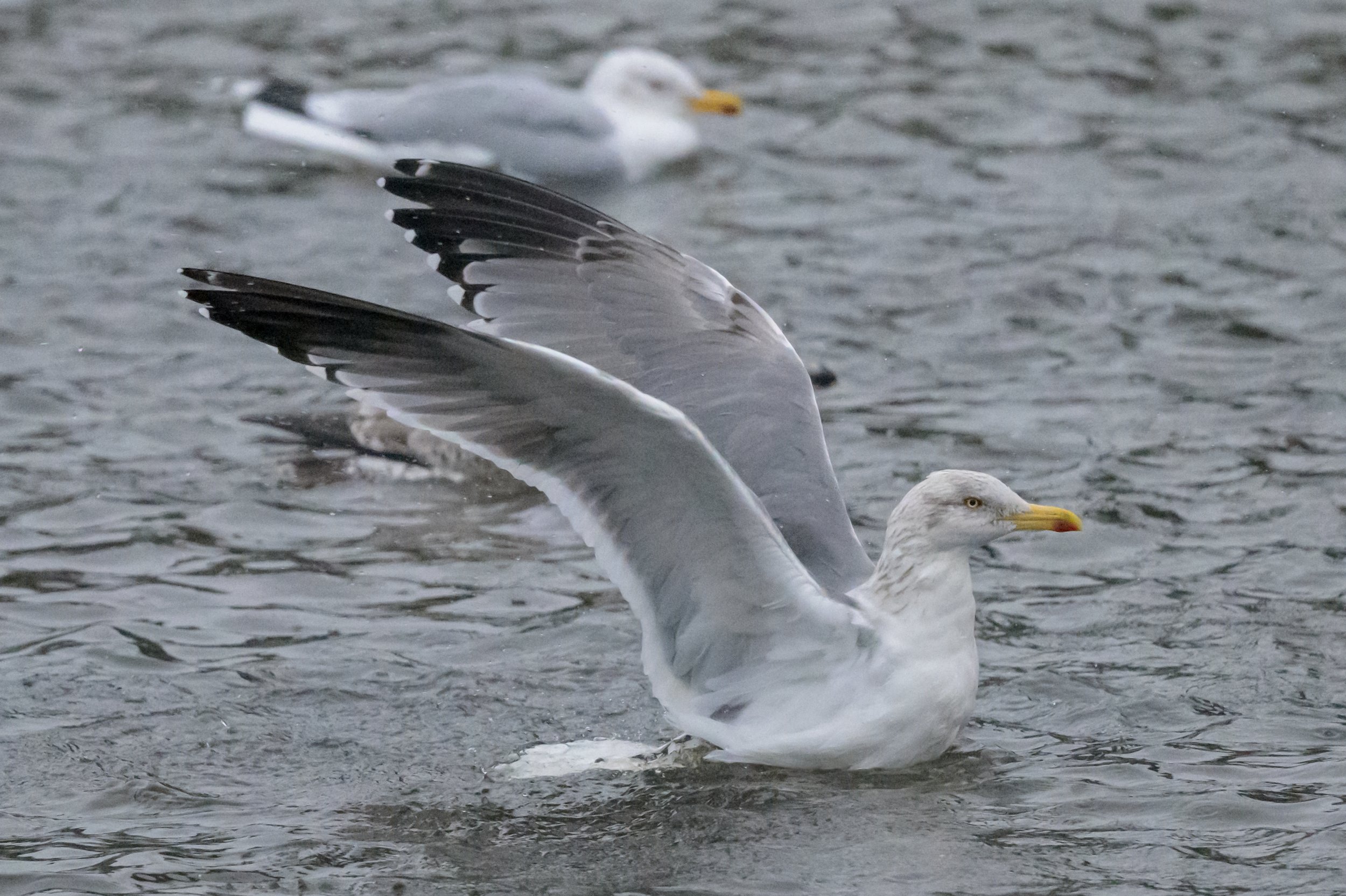

Bird 09. Presumed hybrid European Herring x Lesser Black-backed Gulls, subadult, January 2023, Guilvinec, Brittany, France (Sylvain Reyt). The intermediate mantle tone, slightly closer to EHG than LBBG, serves as a key feature for identifying hybrid candidates. Consequently, ruling out both EHG and YLG can pose challenges for such a bird. In comparison to EHG, this bird exhibits a larger amount of black in the primaries and a smaller mirror on P10. Additionally, it lacks a white crescent in P7, which can also be present in EHG but typically in less advanced (i.e., more immature-looking) individuals. To differentiate it from a YLG, one can consider its small size, orange orbital ring, streaked head and nape (YLGs normally have a white head in January), weak and non-hooked bill, a red spot that does not extend on the upper mandible, and short and dull legs (in contrast to the longer and distinctly yellow legs of YLG).
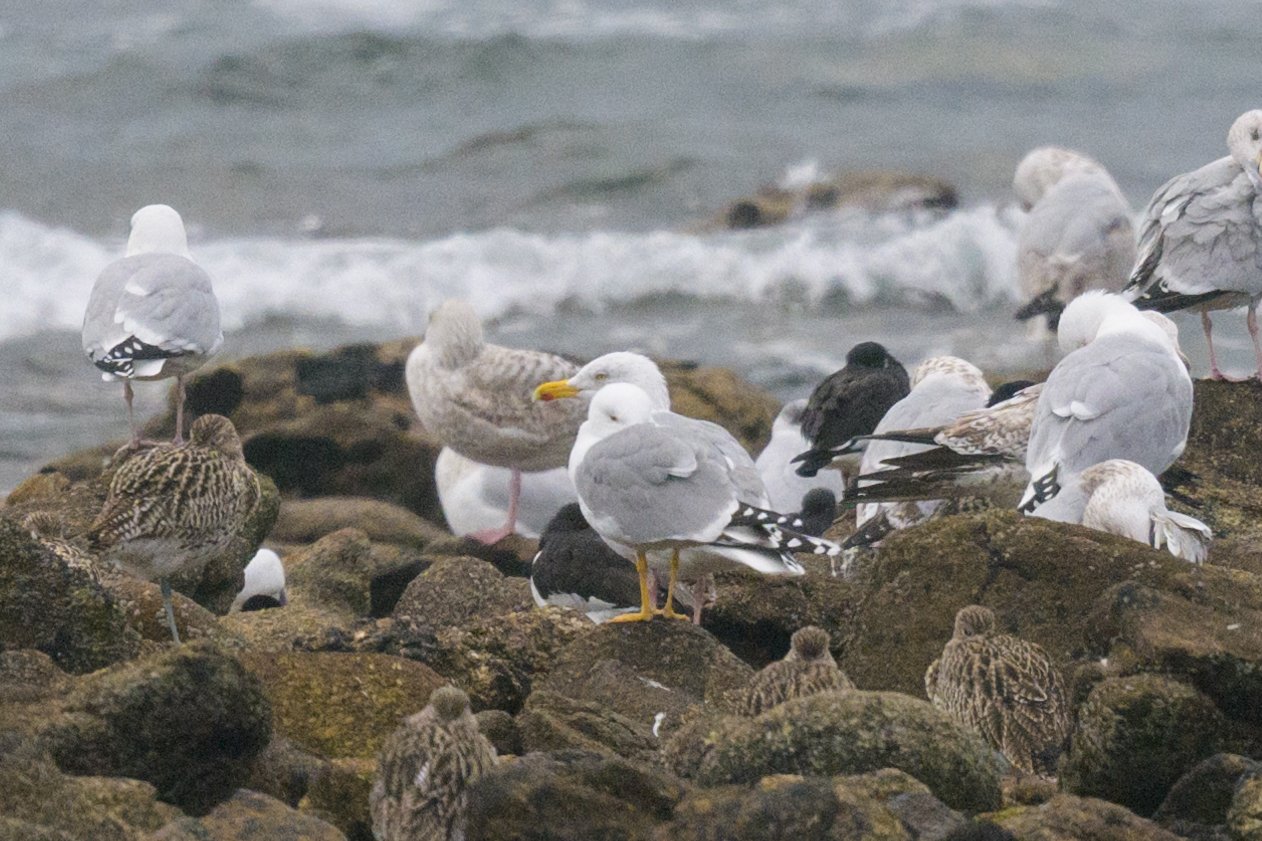
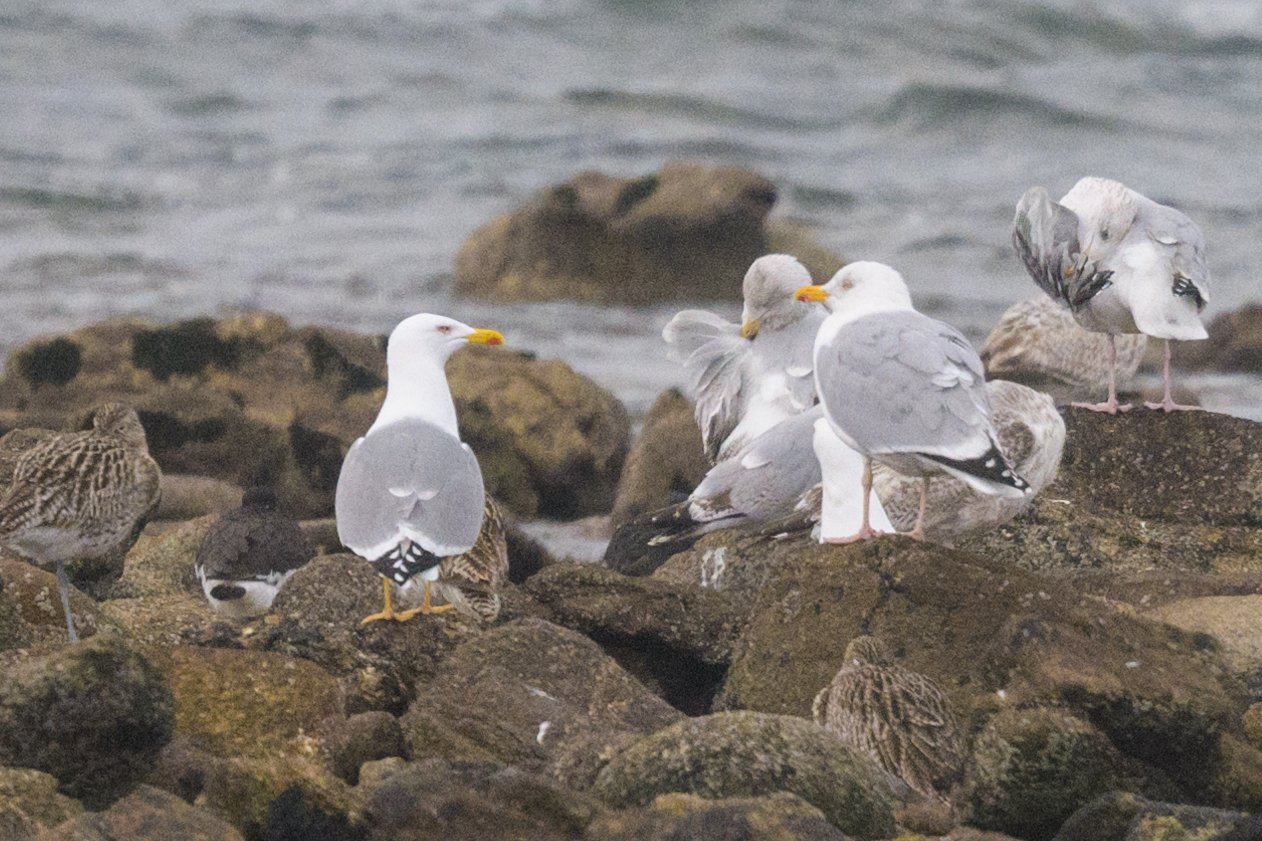


Bird 10. Presumed hybrid European Herring x Lesser Black-backed Gulls, adult, February 2023, Guilvinec, Brittany, France (Sylvain Reyt). This is a more subtle bird, but fortunately, its very yellow legs helped in the identification. Without this distinguishing feature, it would have been challenging to spot among the flock, as its upperparts were only slightly darker than the surrounding argenteus Herring Gulls. The bird swiftly flew away, limiting the opportunity to thoroughly assess its structure. However, it was evidently small-sized, smaller than argenteus EHG, and had a weak bill, which aligns with expectations for EHG or LBBG but is not typical of a YLG.
The open wing views played a crucial role in ruling out a yellow-legged European Herring gull. The primaries displayed a significant amount of black, more consistent with LBBG or YLG, and the white crescent on P7, found between the grey and black parts, was very indistinct while it is normally more prominent in EHG. It is worth noting the presence of two black "spades," reminiscent of EHG and many American Herring gulls as well. In conclusion, this bird exhibits a combination of features that make the hypothesis of a YLG highly unlikely, suggesting a more plausible explanation of hybridization between European Herring gull and Lesser black-backed gull.
Comments on the status in Brittany
Local Status
In the area where I have been regularly birding over the last four years, it appears that I have encountered slightly more presumed hybrids than YLGs. While this observation holds no statistical value and cannot be generalized to other locations, it highlights the fact that these hybrids can be a genuine challenge, particularly in areas where EHGs and LBBGs are abundant. Moreover, it also suggests that their incorrect identification can potentially impact the local status of less common species such as the YLG.
Age-Ratio
As you may have noticed, this report does not include any 1st and 2nd cycle birds. Identifying good hybrid candidates in these age classes can be challenging due to the large variation in their appearance. Although an intermediate mantle tone could serve as a useful clue for 2nd cycle birds, the slight variation in back feather colouration makes identification more difficult. I will continue to be on the lookout for younger hybrid individuals in the future.
Key ID features of the ‘Guilvinec Gull’ hybrids Herring x Lesser black-backed Gull
There is significant variation among the ‘Guilvinec gulls’, likely stemming from the expression of parental traits. However, it is also possible that some hybrids are not first-generation offspring and may result from backcrossing, which could explain the extensive range of variation observed. Genetic data would be required to clarify this matter.
Structure-wise, the compact silhouette and the small size overall both seem to be fairly solid features among hybrids. The intermediate mantle tone also appears to be relatively consistent among the ‘Guilvinec gulls’. However, it is worth noting that birds with mantle colours very similar to EHG or LBBG (potentially due to backcrossing) might easily go unnoticed. In winter, the distribution and appearance of head/neck streaking also prove to be eye-catching, as most birds display streaks on both the head and neck, reminiscent of their parent species. The pattern of the primaries is often intermediate but exhibits considerable variability, ranging roughly from a well-marked EHG to an "average LBBG" pattern (see fig. 01). While there may be additional consistent features among hybrids, these characteristics provide a comprehensive overview of the typical appearance of presumed hybrids.
Fig 01. Variation in extent of black in primaries (P4-10) (Sylvain Reyt). The white tongue tips were not represented in this figure. There is some correlation between the amount of black in each primary, but again variation is large. This figure was designed using pictures from 16 birds from France and the United Kingdom (thus including pictures of birds not featured in this post and collected from faune-france.org, ebird.com and photographers) and it’s therefore worth pointing out that a larger sample could result in a larger extent of variation.
Separation from other gull taxa
Nearctic hybrids - American Herring x Lesser Black-baked Gull or ‘Appledore Gull’
While this post is focused on European taxa, it may also be of interest to North American birders who are likely to encounter similar types of birds. It is important to note that the taxa involved differ, as in a Nearctic context one of the parental species is most-likely the American Herring Gull rather than its European counterpart. In terms of mantle shade, both hybrids (“European Herring x LBBG” vs “American Herring x LBBG”) show no obvious differences. However, there are some variations in winter streaking, which tends to be more extensive in American hybrids, as well as in the amount and distribution of black in the primaries.
As a consequence of the American Herring Gull lineage, American hybrids often exhibit extensive gray tongues and prominent white tongue-tips in black-patterned primaries. This gives some individuals an appearance that is rarely observed in European hybrids. The underside of P10 also displays more variability, ranging from very small and triangle-shaped to long and round- or square-ended, resembling the traits of American Herring Gulls. In North America, the YLG is a rare vagrant, and the hybrids pose the main risk of confusion. Interestingly, the pattern of primaries often appears even more distinct from that of European hybrids. Further features that help to separate Yellow-legged Gull from EHG x LLBG hybrids are discussed in the captions of the following pictures, all taken in America.

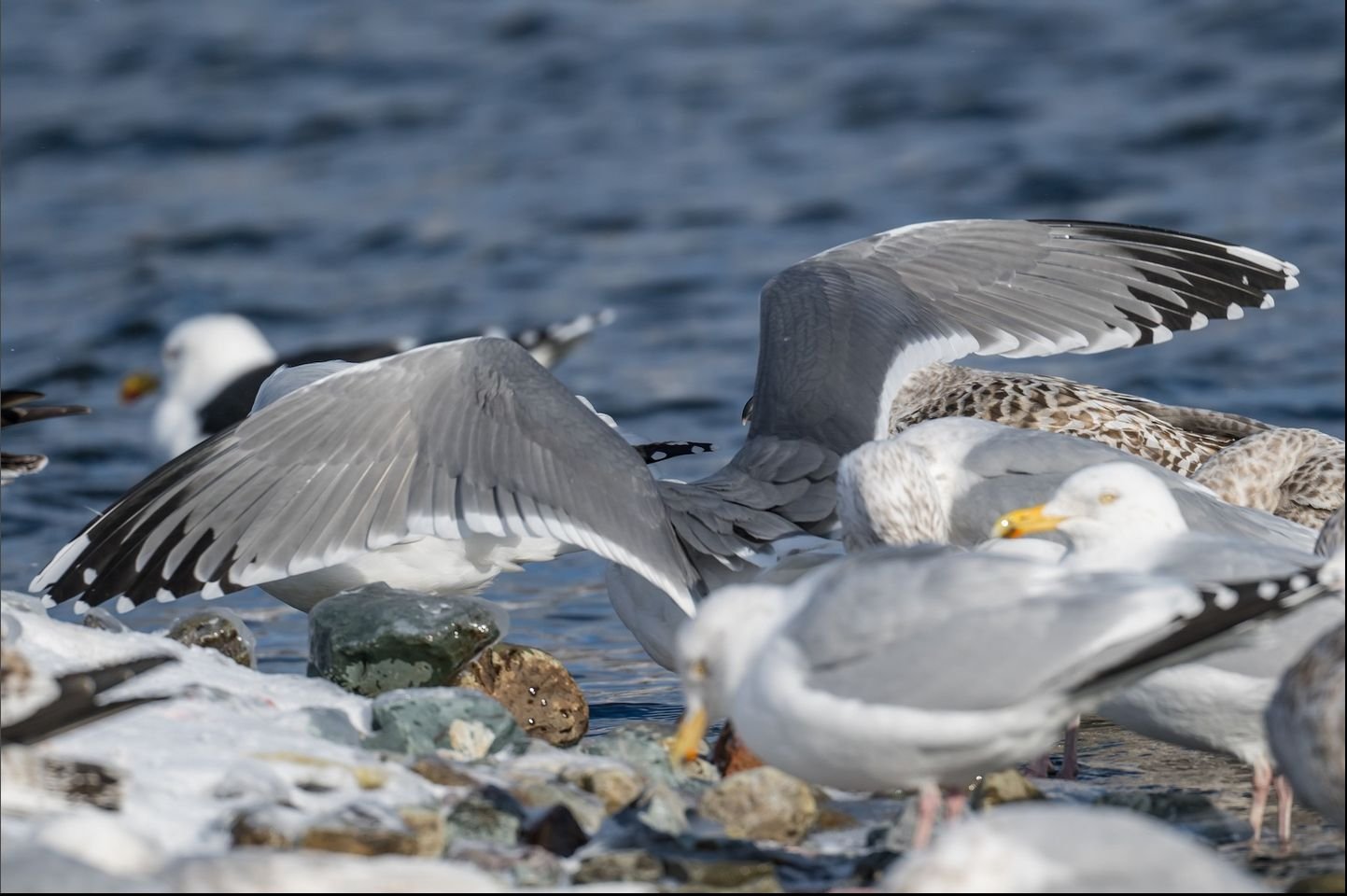
Presumed hybrid American Herring x Lesser Black-backed Gull, adult, March 2022, St John's, Newfoundland and Labrador, Canada (Frank King). Similar to European birds, the intermediate mantle tone is usually what aids in identifying hybrid candidates in the field. This bird, with its extensive grey tongues and prominent white tongue-tips, exemplifies a "typical" American hybrid. It is worth noting that its legs are only yellowish, while the overwhelming majority of YLGs have bright yellow legs. The head colouration falls within the variation observed in European birds but leans towards the darker end.
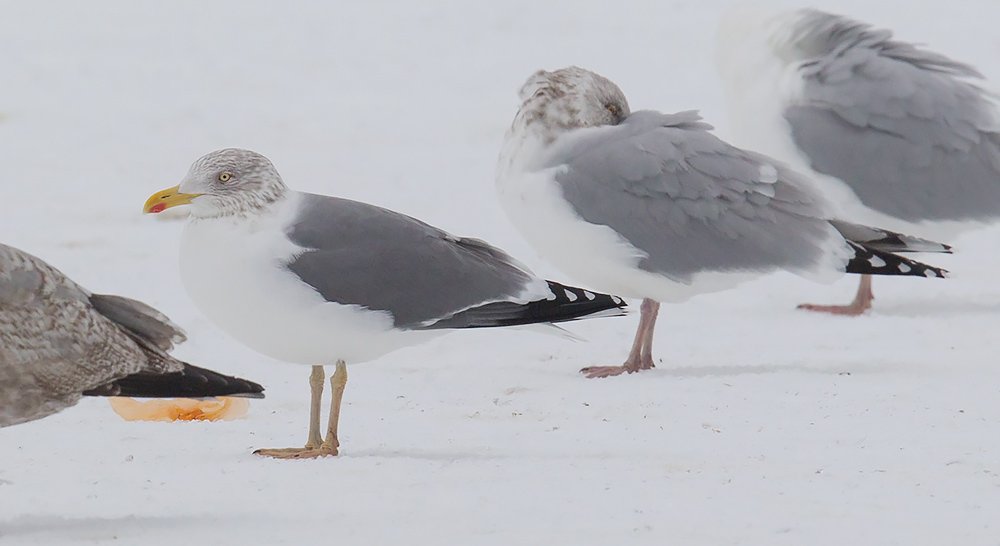

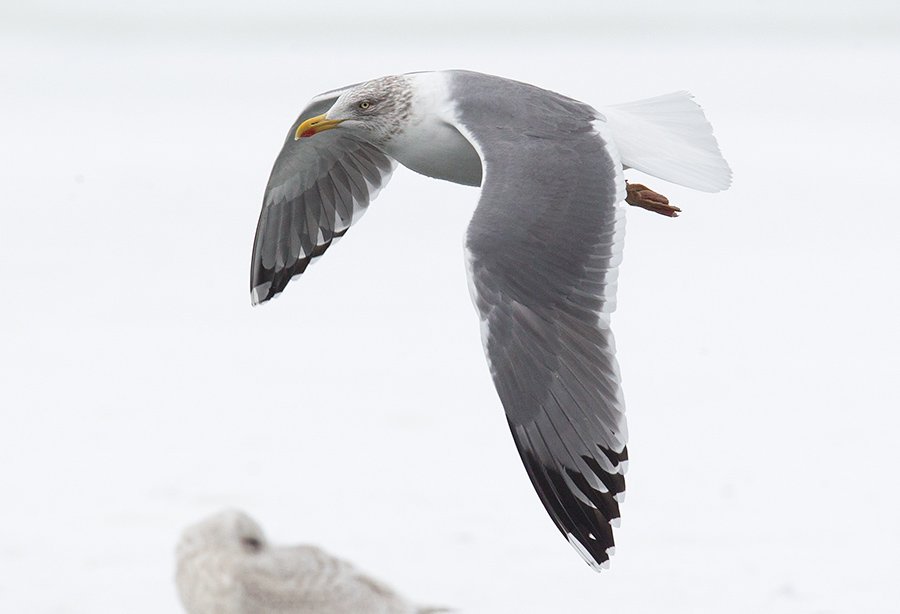
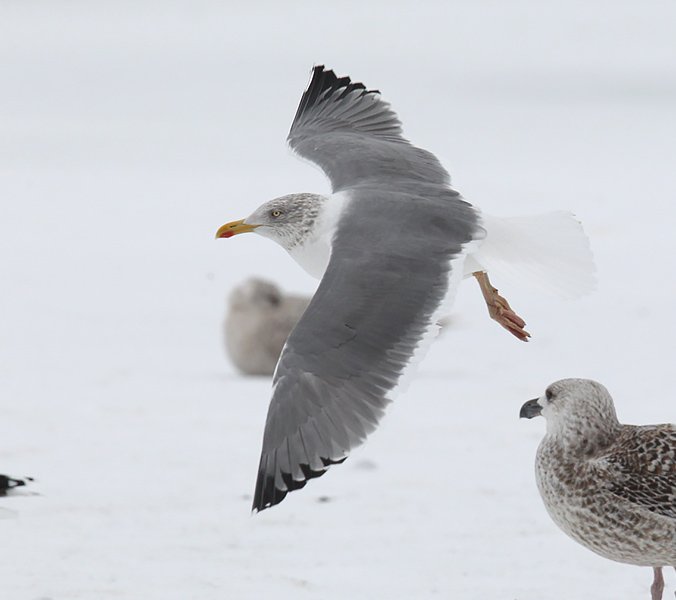
Presumed hybrid American Herring x Lesser Black-backed Gull, adult, February 2017, St John's, Newfoundland and Labrador, Canada (Bruce Mactavish). Here we have another example of a "standard" ‘Appledore gull’, displaying obvious and elongated tongues on the outer primaries. While the head pattern may initially resemble that of Azorean Yellow-legged Gulls with streaking not extending to the breast, upon closer examination, it becomes apparent that the resemblance is not accurate. Azorean birds, unlike this hybrid, exhibit streaking that extends to the forehead, lores, and chin but does not reach the lower neck (Adriaens et al., 2020). Among numerous other features that are incompatible with any Yellow-legged Gull, it is also noteworthy the very long tongue on the underside of P10 in this specimen.
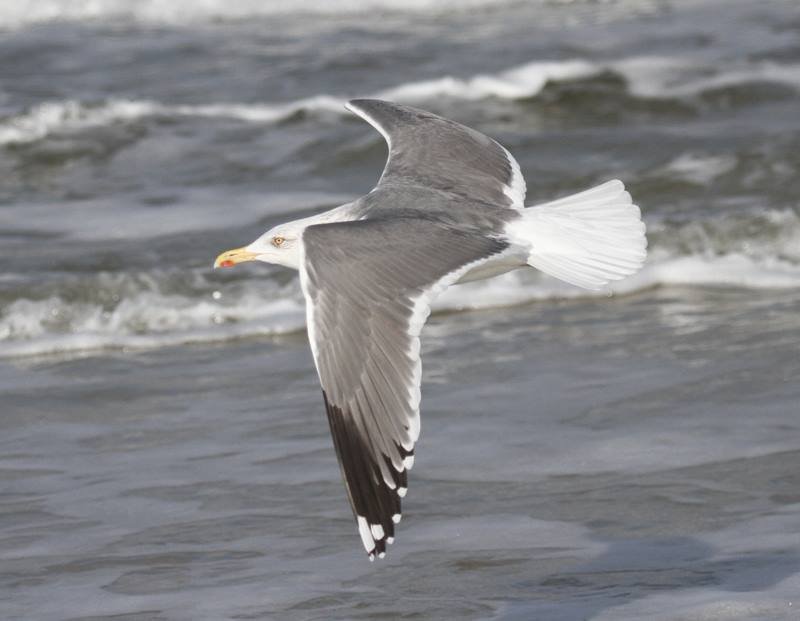
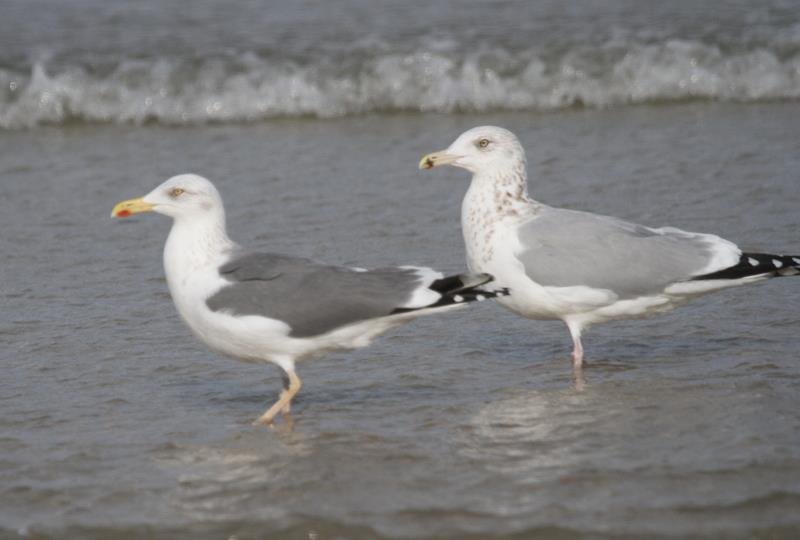
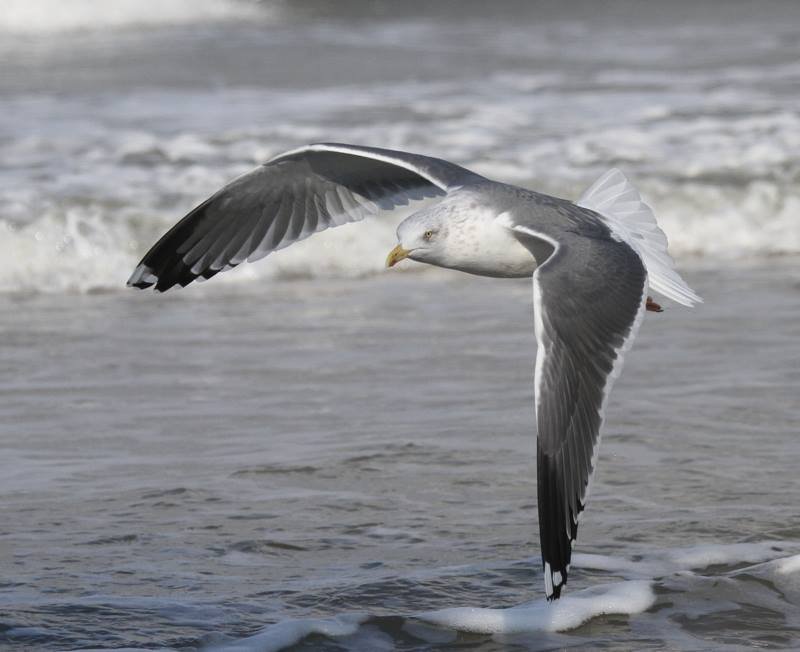
Presumed hybrid American Herring x Lesser Black-backed Gull, adult, January 2016, Daytona Beach Shores, Florida, USA (Michael Brothers). This last example exhibits both a large P9 mirror and a greater extent of black towards the base of the outermost primaries. In the picture with the bird at rest, note its smaller size and slender structure compared to the American Herring Gull.
European taxa: separation from Yellow-legged, Northern Herring (ssp argentatus), and Heuglin’s Gulls
Back in Europe, the primary risk of confusion lies with the YLG. However, it is worth considering whether this species could be involved in the hybrid lineage. Several factors suggest that this is unlikely. Firstly, the local context, particularly regarding birds from Guilvinec, and the winter status of YLG in western Brittany do not support such a possibility. Secondly, as we have observed, none of the birds displayed a structure reminiscent of YLG. Therefore, when specifically addressing the question of distinguishing the ‘Guilvinec gulls’ from YLG (of any subspecies), it’s key to assess the bird's structure accurately. Additionally, examining various plumage features such as the orbital ring, leg colour, head streaking, and wing-tip pattern should be sufficient to confirm the identification.
Another potential pitfall could be the northern subspecies argentatus of the European Herring Gull, which shows considerably darker upperparts compared to the local argenteus. In such cases, the key id features include the bird's structure (argentatus being typically more robust than argenteus and presumed hybrids) and the primary pattern (argentatus generally exhibiting more white than argenteus). However, it’s important not to rely too heavily on leg and orbital ring colours for ruling out this taxon since argentatus show greater variation in these aspects. For example, Northern birds can show yellow or orangish orbital rings like in argenteus but some get a deep orange or reddish colour.
When encountering a late-moulting bird, it is worth considering the separation from Heuglin's Gull. Nevertheless, differentiating between the two should be straightforward, primarily relying on features such as the primary and head’ patterns.
Acknowledgements
I am grateful to Marcel Gil Velasco and Guillermo Rodríguez Lázaro for their comments and to Michael Brothers, Frank King and Bruce Mactavish for providing photos.

